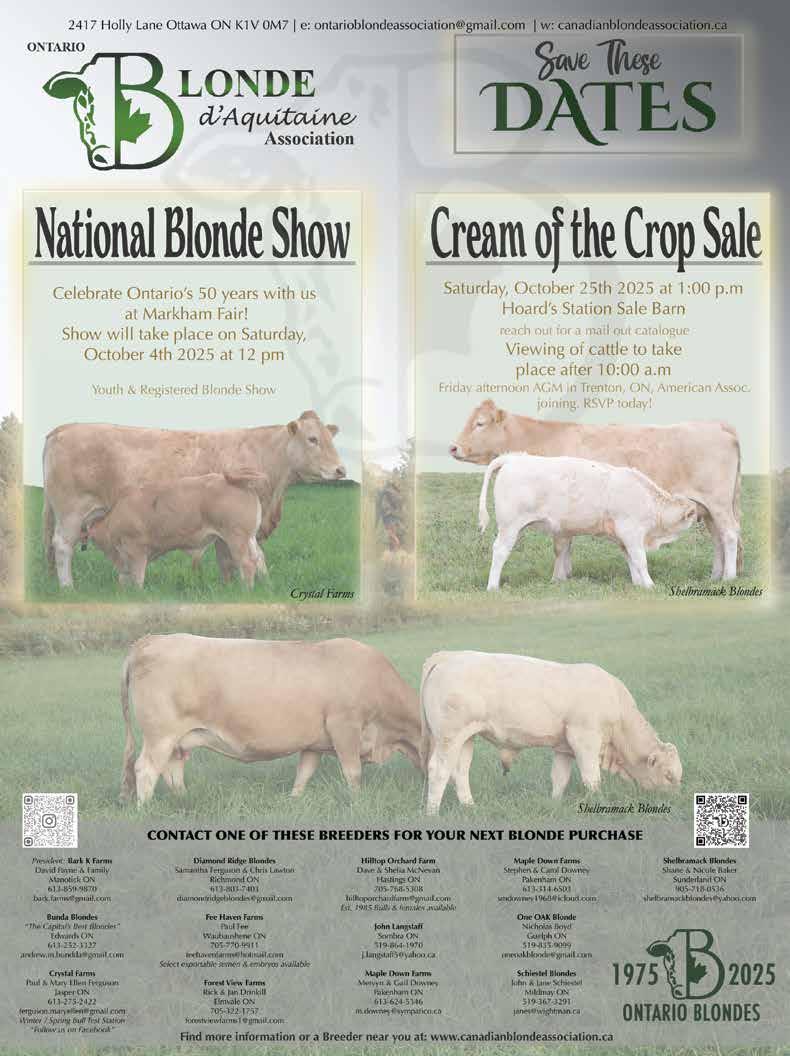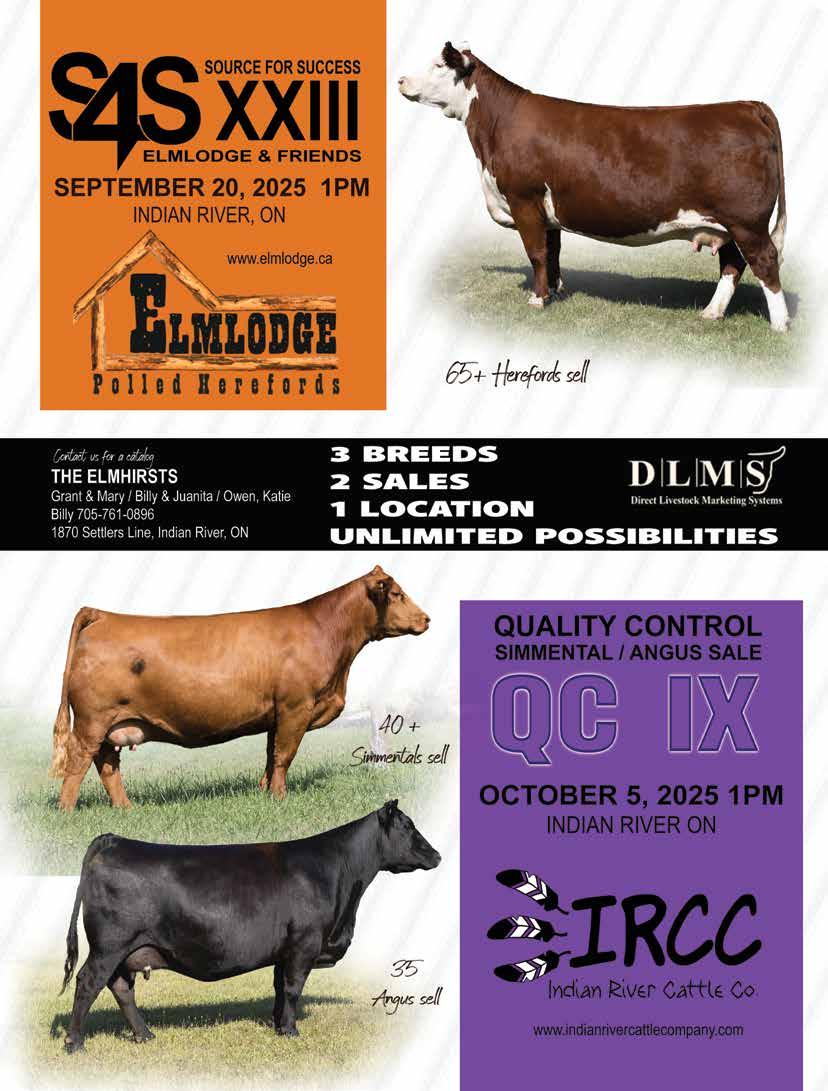

YOUTH ALLIANCE EXPLORES MANITOULIN ISLAND
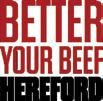
THE MOST EXCITING TIME OF YEAR
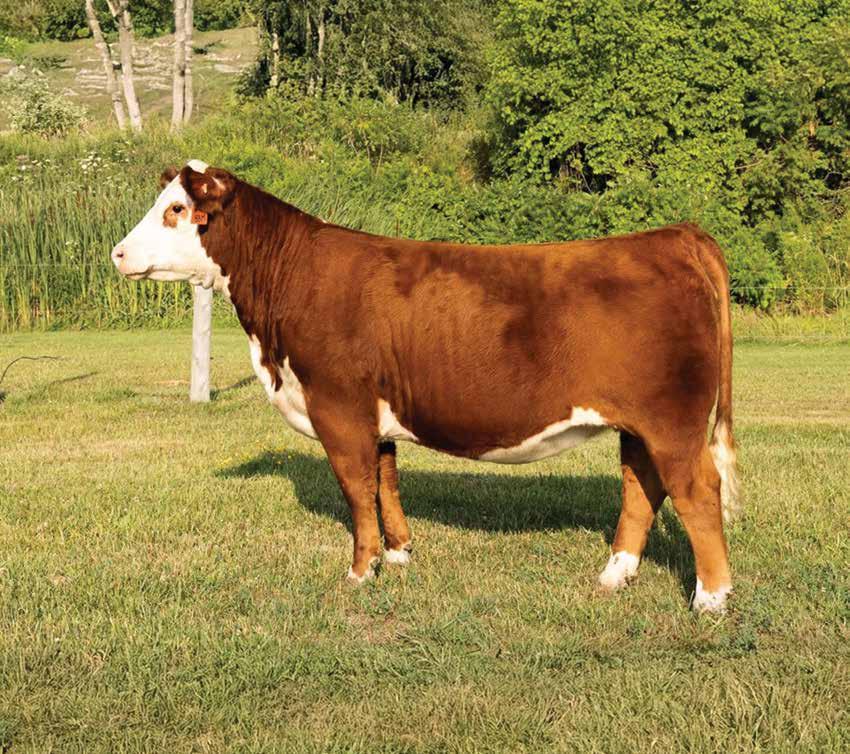
Example of quality being sold on Hereford Sale weekend in Ontario You’ll find TAX 53M in Source for Success XXIV on September 20.
Hereford Happenings
River Valley Hereford Genetics Design - September 19th, Newburgh Elm-Lodge Polled Herefords and Friends Source for Success XXIV - September 20th, Indian River Medonte Highlands Polled Herefords and Friends Autumn Alliance - September 21st, Orillia
Fall Round Up Hereford Sale
Several guest Consignors invite you to join them October 4th, 1:00pm at Hoards Station Community Livestock Exchange, Campbellford
HIDDEN-VIEW POLLED HEREFORDS
Joe and Karen Paszternak NORWOOD, ON 705-9573739 or 705-957-7470 karen.paszternak@gmail.com Bulls & Females for sale
JDL CATTLE CO. & D&S LIVESTOCK
David & Shirley Lasby
Josh Lasby, Justin & Jaimie Lasby & Family, Jessica Lasby & Travis Fulford & Family
MULMUR, ON 519-943-4147 or 519-278-6819
jessica.lasby@hotmail.com
Good-looking, Sound, Functional Cattle!
www.ontarioherefordassociation.com
LIAN MOR POLLED HEREFORD
Wally & Fern Pugh MONO, ON
Wally & Fern Pugh lianmor48@gmail.com · 519-941-8515
Trevor & Amy tpugh27@yahoo.com · 519-939-7489
Breeding Stock Available
MEDONTE HIGHLANDS POLLED HEREFORDS
3055 Universal Dr. Mississauga, Ontario (905) 625-3151
maria@standardmechanical.com
“6 Star Breeder”
O’SHEA FARMS
Jamie and Mel O’Shea DENFIELD, ON 519-477-1238
osheafarms@hotmail.com Bulls and Females for sale
WHISKEY LANE LIVESTOCK Herford and Angus Scott, Paula, Jason and Shelby Cornish INDIAN RIVER, ON 705-295-2925
705-878-3248 (Scott’s Cell) 705-341-3220 (Paula’s Cell) wll@nexicom.net
Visitors Always Welcome
SCOTT CORNISH | Indian River, ON • 705-878-3248 • scott.cornish@eastgen.ca PRESIDENT JESSICA LASBY | Meaford, ON • 519-939-0283 • ontarioherefordassociation@outlook.com SECRETARY MANAGER


ON THE COVER:
Thank you to Derek, Karen and Jaden Jeffs of Campbellford, Ontario for sharing this cover photo of their cattle enjoying some fresh spring grass. The summer months have been busy for BFO’s producer relations team as they plan and deliver a number of education events. In June, we welcomed the return of our Feedlot Management School in conjunction with the Ontario Cattle Feeders’ Association to a sold-out crowd in Huron and Bruce Counties. You can read more about this event on page 22. In early July, our Ontario Beef Youth Alliance set sail for a trip to Manitoulin Island where 35 individuals had the chance to explore farm life on the world’s largest fresh water island. Read more about this adventure on page 10. The team is now busy finalizing plans for our annual Cow-Calf Management Tour, which will visit eastern Ontario in late August.
Don’t miss out on submitting your photos for our October issue. Please send your fall-inspired photos by September 15 to be considered for the cover. Digital photos in portrait orientation that are at least 300dpi are preferred, and can be emailed to
ONTARIO BEEF • Beef Farmers of Ontario 130 Malcolm Road, Guelph, ON N1K 1B1 • Phone: 519-824-0334 • Toll Free (for Ontario callers only) 1-866-370-BEEF (2333) Fax: 519-824-9101 • info@ontariobeef.com
EDITOR
LeaAnne Wurmli
CIRCULATION COORDINATOR
Charlene Yungblut
ADVERTISING MANAGER
Cathy Lasby, Preferred Agri-Marketing Services Guelph, ON Phone: 519-763-8833 • Fax: 519-763-8833 pams@sentex.net
DESIGN and LAYOUT
Prism Studios Advertising and Design Inc. Guelph, ON
PRODUCTION and PRINTING
Beck’s Printing Services, Brantford, ON
PROVIDING A FORUM FOR THE ONTARIO BEEF INDUSTRY
Ontario Beef is the official publication of the Beef Farmers of Ontario. Contents of this publication may be reproduced only by permission of the Editor and with credit acknowledged.
Opinions expressed herein are those of the author and/or editor and do not necessarily reflect the opinion of the Beef Farmers of Ontario. Publication of advertisements does not constitute endorsement or approval by Ontario Beef or the Beef Farmers of Ontario of products or services advertised.
Advertising deadlines are January 10, April 15, July 15, September 15 and November 15. The publisher reserves the right to refuse or cancel any advertising, including advertising that is inconsistent with BFO’s Sponsorship Policy, available at www.ontariobeef.com. Every effort is made to ensure the accuracy of material published, however no responsibility can be assumed for advertising not received in clear, type-written form.
Canadian Publications Mail Product Sales Agreement Number 0040007029
POSTMASTER: Return undeliverable Canadian addresses to: Beef Farmers of Ontario, 130 Malcolm Road, Guelph, ON N1K 1B1

SummerGrill, Gather and Grow AHEAD OF THE HEARD
By Craig McLaughlin, BFO President info@ontariobeef.com • www.ontariobeef.com
is a hectic time for beef farmers - there’s a never-ending to-do list and no shortage of uncertainties. Unpredictable weather, unreliable equipment that somehow still needs to keep running, and yes, even those questionable “relatives” who show up at the most inconvenient times.
Summer is also a season for grilling on the barbecue, gathering around picnic tables, campfires, or for field meals, and witnessing the results of our spring hustle as we watch our crops and cattle grow. As you’ll read in my column this month, summer activities at BFO have followed a similar theme – we hosted our annual barbecue at Queen’s Park, gathered for a number of farm tours, and we’re focused on finding ways to grow our sector, particularly by improving our Breeder Finance Program to provide attractive financing to new and beginning farmers.
To kick off grilling season, we returned to Queen’s Park in May to host our highly anticipated annual barbecue and lobby day on the lawn of the Ontario Legislature, and just prior to Ontario’s Local Food Week. This day has become an invaluable advocacy tool for our association and our members. Aside from our barbecue, we met individually with 17 MPPs from all parties to discuss our provincial priorities and thank the government for their increased support for Ontario’s Risk Management Program, which was announced in January of this year. Over the lunch hour, we served an all-Ontario meal featuring Ontario Corn Fed Beef, which included appearances by the Premier, the Lieutenant Governor of Ontario, the Minister of Agriculture and NDP and Green Party leaders, who all generously helped to serve beef. You can read more about our day at Queen’s Park by turning to page 6 and page 16.
BFO BOARD OF DIRECTORS 2025
Craig McLaughlin (Eastern Director) – President
Phone: 613-504-1863 • Email: cmblackhorse@gmail.com
Jason Leblond (Northern Director) – Vice President
Email: jacres5@gmail.com
Don Badour (Cow-Calf Director)
Email: don.badour@gmail.com
Don Hargrave (Cow-Calf Director)
Email: dchargrave@gmail.com
Jim Whitley (Cow-Calf Director)
Email: modelaranch@hotmail.com
Joost van der Heiden (Background Director)
Email: jcvdheiden@hotmail.com
Nick Martin (Feedlot Director)
Email: nickolas@pureislandbeef.com
Jairus Maus (Feedlot Director)
Email: ellengowanfarms@gmail.com
Tom Kroesbergen (Feedlot Director)
Email: tomkroes50@hotmail.com
Denise Byers (Southern Director)
Email: byersdimmick@yahoo.com
Ralph Eyre (Director-At-Large)
Email: ralph@eyrefarms.ca
Kim Jo Bliss (Director-At-Large)
Email: kimjobliss@gmail.com
Emily Bromley (Youth Director)
Email: fondoak@live.ca
On the policy front, our efforts have been focused on a pitch to the provincial government to establish a government-backed Breeder Loan Guarantee Program, which would build on the 35-year success of the government-backed Ontario Feeder Cattle Loan Guarantee Program. While not a direct financial ask of the province, a government-backed guarantee would result in competitive financing from lenders, help farmers purchase breeding cattle and support the expansion of Ontario’s cow herd. To support our ask, we launched an online survey for producers to share feedback on access to financing and interest in an enhanced Breeder Loan Guarantee Program. With 175 respondents, the results were affirming, which will certainly help to build our ask.
Of course, we also continue to be engaged with the Canadian Cattle Association (CCA) and the National Cattle Feeders’ Association on our trade relations with the United States. A delegation from CCA recently attended a summer meeting of the National Cattlemen’s Beef Association where they reported having positive discussions with leadership and staff on the significance of the working relationship between our two countries specific to the movement of beef and cattle.
I spent most of June traveling and attending many national meetings on behalf of CCA, the Canadian Beef Cattle Checkoff Agency and the National Farm Animal Care Council. I also represented BFO at the British Columbia Cattlemen’s Association’s annual meeting in Cranbrook. It’s always nice to visit the other provinces to get a perspective on national needs and issues, and meet with farmers and ranchers from across the country.
BFO STAFF
Executive Director
Richard Horne • richard@ontariobeef.com
Manager of Policy and Issues
Thomas Brandstetter • thomas@ontariobeef.com
Senior Policy Advisor
Evan Chaffe • evan@ontariobeef.com
Policy Advisor
Aynur Izzettin • aynur@ontariobeef.com
Director of Communications
LeaAnne Wurmli • leaanne@ontariobeef.com
Manager of Public Engagement and Digital Strategy
Jennifer Kyle • jennifer@ontariobeef.com
Engagement Coordinator
Charlene Yungblut • charlene@ontariobeef.com
Member Information Coordinator
Jamie Gamble • markets@ontariobeef.com
Accountant
Amber McIntyre • amber@ontariobeef.com
Office Manager
Lisandra Lima • lisandra@ontariobeef.com
Manager of Producer Relations & Director of the Ontario Beef Youth Alliance
Jaclyn Horenberg • jaclyn@ontariobeef.com
Senior Producer Relations Advisor
Dan Ferguson • dan@ontariobeef.com
Producer Relations Specialist
Robert McKinlay • robert@ontariobeef.com
Manager of Compliance
Chris Millar • chrism@ontariobeef.com
Supervisor of Provincial Programs
Barb Caswell • barb@ontariobeef.com
Between wheat harvest and hay, our producer relations team has been busy planning and delivering a number of our annual education events. In June, we welcomed the return of our Feedlot Management School in conjunction with the Ontario Cattle Feeders’ Association to a sold-out crowd. Special thanks to Bennett & Sons Farms Ltd., Schaus Land & Cattle Company, Steve Eby and Ellengowan Farms for hosting our tour this year, and to all guest speakers and sponsors who supported the event. In early July, our Ontario Beef Youth Alliance set sail for a trip to Manitoulin Island where 35 individuals had the chance to explore farm life on the Island. Again, we appreciated all of our hosts who opened up their farms – Forbes Farm, Pallister Farms, Sharpe Farm Supplies, Silver Spring Farms and Pure Island Beef, and the Martin family for being exceptional tour guides. The team is now busy finalizing plans for our annual Cow-Calf Management Tour, which will visit eastern Ontario later this month. In July, we invited our advisory councillors and committee members to Hastings County for our annual summer meeting. Throughout the two-day event, we provided an update on our policy and advocacy files, our producer engagement work, and had three
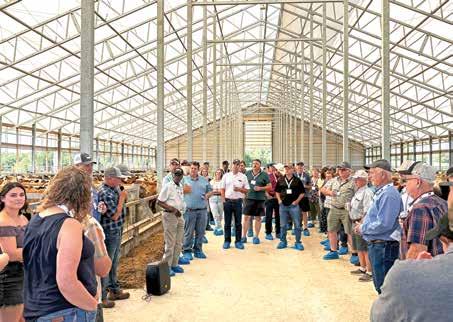
separate presentations on Ontario’s Meat Inspection Program by OMAFA’s Chief Veterinarian, Dr. Greg Worley and Tim Metzger, a national update by CCA’s President, Tyler Fulton, and a cattle market outlook from OMAFA’s Chief Economist, Steve Duff. In addition to the business portion of the meeting, we hopped on a couple of school buses and headed to visit the Palmateer family and Enright Cattle Company near Tweed where we had the opportunity to see the Palmateer’s new feedlot barn and the Enright’s new virtual fencing system at work. Following the farm tour, we enjoyed some eastern hospitality at Potter Settlement Winery for a summer barbecue picnic. I would like to sincerely thank the Palmateer family, the Enright family, Darrell and Sandra Russett and the entire Beef Farmers of Hastings County team for their hospitality and generosity in helping us plan our meeting this year.
As summer draws to a close, I hope you take time to enjoy a good steak with family and friends, and all the best for a successful harvest and calf run this fall.
Beef farming: Only for the brave. OB
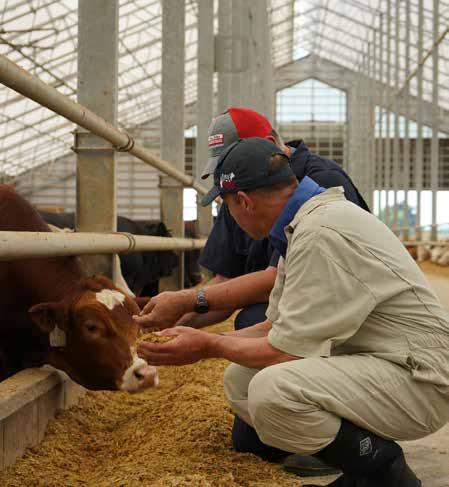

AsNewest Member of the Herd THE BEEF BEAT
By Aynur Izzettin, BFO Policy Advisor aynur@ontariobeef.com • www.ontariobeef.com
I begin this new chapter in my professional career, I am thrilled to introduce myself in this issue of the Ontario Beef magazine. My name is Aynur Izzettin, and I have recently joined Beef Farmers of Ontario (BFO) as the new Policy Advisor. I hold a Bachelor’s degree in Political Science from Wilfrid Laurier University, having graduated in 2023, and most recently worked on the policy team at the College of Veterinarians of Ontario as an Associate in Project Research. I am eager to contribute to the important work BFO does, and to support the vision and voices of the dedicated producers who drive this industry forward.

farmers, and to pave the way for continued agricultural growth.
During my second week at BFO, I had the opportunity to attend the 17th annual Queen’s Park Barbecue and lobby day in Toronto with the board of directors and staff. We proudly served beef on a bun alongside fresh, Ontario-inspired salads to Queen’s Park staff, MPPs, Ministers and their teams.
Additionally, we handed out delicious biltong sourced from Florence Meats and premium beef tallow lotion from J&E Meats –both proudly showcasing the quality and craftsmanship of Ontario beef products. It was an incredible turn-out, having served over 500 people. Premier Doug Ford also attended our event to show his support for Ontario beef farmers and even helped cut and serve beef. Throughout the day, we met with a number of MPPs to share important key priorities for Ontario’s beef sector. These conversations centered on how farmers and government leaders can collaborate to strengthen the sector’s long-term sustainability through investments and thoughtful policy in order to support the financial stability of
During our meetings, we thanked all MPPs for the $100 million increase in investment and continued commitment to Ontario’s Risk Management Program. Additionally, we proposed a governmentbacked Breeder Loan Guarantee Program to enable competitive financing for farmers and support the growth of Ontario’s cow herd. This program is meant to mirror that of the Ontario Feeder Cattle Loan Guarantee Program to assist young farmers entering the industry and to grow the grazing sector and support our pasturelands.
To address the ongoing shortage of large animal veterinarians, discussions focused on enhancing incentive programs and increasing investment in the Veterinary Assistance Program to attract and retain professionals, particularly in northern Ontario and rural communities. The Collaborative Doctor of Medicine Program between Lakehead University and the University of Guelph aimed at addressing the shortage of veterinarians in northern Ontario is set to launch this fall. The Ontario government is investing $2 million through the Northern Ontario Heritage Fund to help Lakehead University, in partnership with the University of Guelph, build a new animal education facility
and purchase equipment for hands-on veterinary education. The program also received a $10 million investment from Kim and Stu Lang to help fund the construction efforts for the facility on Lakehead University’s Thunder Bay campus.
Other key priorities discussed at Queen’s Park included:
• Improving the viability of meat processors, with the conversations exploring property tax relief measures for small and medium sized abattoirs and new investments in infrastructure and facility expansion.
• Supporting the growth of Ontario’s agri-food land base, directors and staff emphasized the need for increased investment in community pastures and greater policy flexibility to allow farmers access to Crown Land for food production.
• The topic of carcass condemnations under Ontario’s Meat Inspection Program was brought forward to Minister Trevor Jones, and the need to reduce the prevalence of them at provincial plants.
• Finally, the Provincial Animal Welfare Services (PAWS) Act was discussed, with a focus on developing a distinct and tailored system of enforcement and regulatory frameworks for livestock similar to models used in other jurisdictions.
My first experience attending Question Period during the lobby day was certainly engaging, as the debate centered around Bill 5, Protect Ontario by Unleashing Our Economy Act, 2025. During the session, opposition members cited concerns about its potential impact on broader communities. In response, the government emphasized that Bill 5 represents a significant economic opportunity for the province.
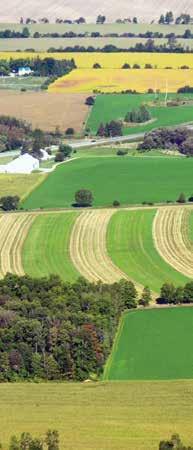
Overall, the barbecue and lobby day was very productive with lots of strategic conversations and favourable exchanges.
In June, I had the privilege of accompanying the BFO Policy Team on the Ontario Legislature Internship Programme (OLIP) Tour. The day began with a visit to the Ontario Beef Research Centre in Elora, where the interns were introduced to cutting-edge research focused on improving cattle feed efficiency, enhancing weight gain, and mitigating methane emissions. Research staff provided valuable insights into the innovative practices and technologies being tested to advance the sustainability and productivity of Ontario’s beef sector. The tour then continued at the Grey-Dufferin Community Pasture, where pasture manager Mike Swidersky delivered information on the region’s biodiversity and the importance of ecological stability. He also highlighted the benefits of rotational grazing in promoting forage and soil health, and overall pasture resilience. The OLIP interns expressed that the tour was one of their favourite tours they took part in this year. They left with a significantly deeper understanding of Ontario’s agricultural systems, particularly the complexities and innovations within the province’s beef cattle industry.
That wraps up my first column! I’m excited for what lies ahead in this dynamic industry. If you have any questions or concerns in your county or district, please do not hesitate to connect with any member of our policy team. I hope you all have a productive end to the summer on the fields and in the barns! OB
Elgin County Young Farmer Named CYL Semi-Finalist
By Charlene Yungblut, BFO Engagement Coordinator
The Canadian Cattle Young Leaders (CYL) program was established in 2010, and is open to young people across Canada who are between the ages of 18 to 35 and are involved in various aspects of the beef supply chain. These young beef enthusiasts are paired with an industry leader in their specific area of interest for a nine-month mentorship. Through this experience, the Canadian CYL program acts as an industry succession planning tool to equip the next generation of leaders with skills and resources to continue to drive growth and profitability in the Canadian beef sector.
Out of an impressive group of applications, 24 semi-finalists are invited to participate in the annual Canadian CYL selection competition during the Canadian Cattle Association’s Semi-Annual Meeting, hosted this year in Levis, Quebec. During this competition, semi-finalists will participate in judged roundtable discussions on timely beef industry related topics to compete for a spot in the upcoming program year. Following the selection competition, 16 finalists will be paired with a hand-picked mentor with expertise in the mentee’s specific area of interest. Program participants are granted a $3,000 budget to fund their engagement at various industry events and learning opportunities throughout the year.
This year, Ontario has one semi-finalist, Abbey Taylor, who will be participating in the selection competition in September. BFO is proud to be well-represented by such a passionate young leader and
we wish her well as she competes in Quebec.
Let’s meet Abbey!

Abbey is the farmer behind Dawn Farm, a grass-finished beef operation near Belmont, Ontario. Abbey is a seventh-generation farmer, she grew up on her family’s grain farm and continues to be involved with that operation.
After completing her Diploma in Agriculture at Ridgetown Campus in 2019, she went on an “agventure” across Canada. She toured dozens of farms and worked several jobs, including herding cattle in the Quebec hills, driving a combine for harvest in Saskatchewan, and helping at an abattoir in British Columbia. Her five-month journey reinforced her dream of owning a farm.
As a result, Abbey started Dawn Farm in 2021 out of a love of cattle and pasture ecosystems and desire to provide delicious beef to her community. She is passionate about grass management and loves building a community with her customers.
Abbey was also the recipient of the 2025 Ontario Pasture Award, which was awarded by the Ontario Forage Council, DLF and BFO earlier this year. OB
ONTARIO BEEF FARMERS: WE NEED YOU
Raising beef is vital to your family, your farm, your community, and Ontario as a whole. The product you raise deserves to reach appreciative family tables close to home, ensuring you receive the best value for your hard work. At VG Meats, we’ve partnered with small beef farmers across Ontario who share our commitment to quality, sustainability, and continuous improvement. Now, we’d like to work with you.
We’re looking to purchase your finished cattle and provide you with valuable data on each animal’s tenderness, yield, quality, and weight. This information not only helps you secure a premium for your beef but also supports better management and genetic decisions for generations to come. By working together, we can help regenerate the lives, profits, and land of Ontario’s beef farming families.

Over the years, we’ve also expanded our connections across Ontario’s retail landscape, creating more opportunities for locally raised beef to reach appreciative consumers. You can learn more about this exciting initiative and how it benefits Ontario farmers at harvesttogather.ca
If your family finishes cattle and you’re ready to explore this opportunity, reach out to me, Cory Van Groningen, at cory@vgmeats.ca, and I’ll share the details of our program. Let’s schedule a time to discuss how VG Meats can help bring your beef to market while supporting your farm’s growth. We look forward to hearing from you soon.





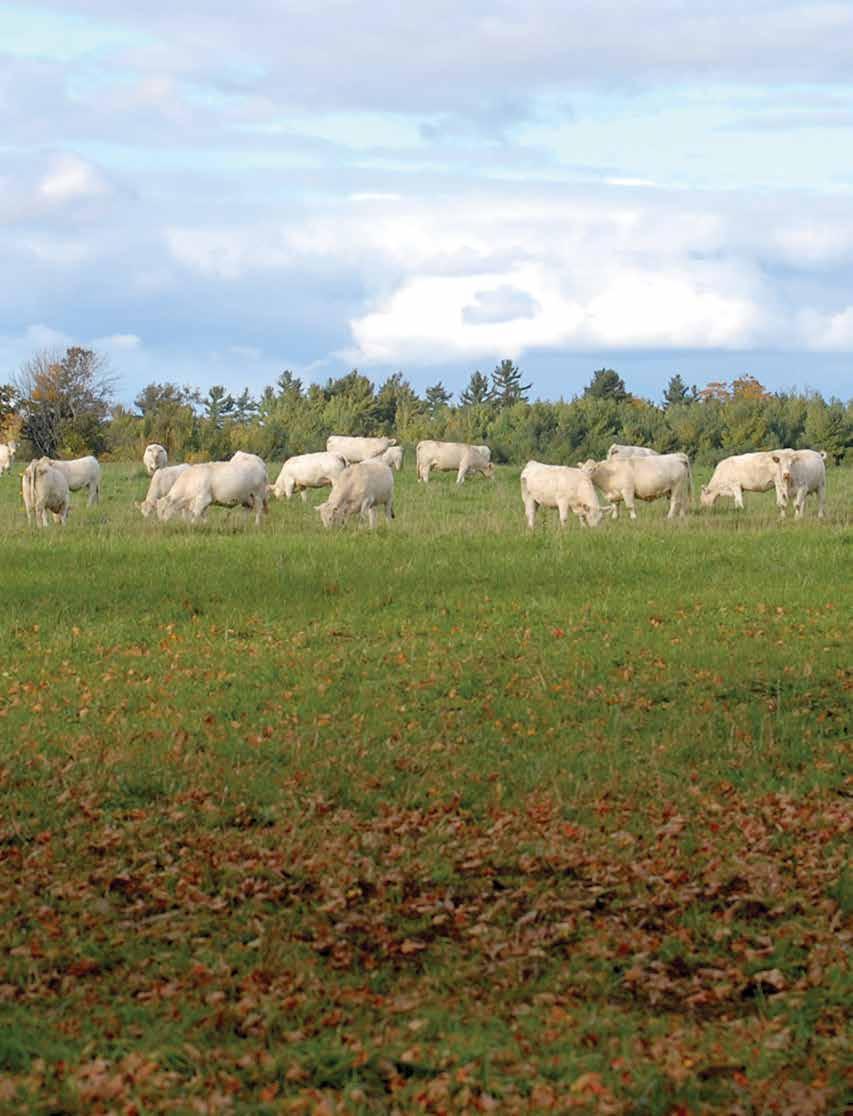
Find ONTARIO CHAROLAIS genetics at these fall events.
Renfrew Fair • September 6, Renfrew, ON
Lindsay Exhibition • September 19, Lindsay, ON Uppin’ The Ante Female Sale • October 17, Hanover, ON
Fall Feature Female Sale • October 18, Hoards Station, ON
Royal Agricultural Winter Fair Charolais Show • November 7, Toronto, ON
We encourage you to tour ONTARIO
this summer and fall and see the excellent Charolais Females FOR SALE privately too.
Youth Alliance Explores Manitoulin Island
By Jaclyn Horenberg, BFO Manager of Producer Relations
The Ontario Beef Youth Alliance (OBYA) continues to grow in numbers, attracting individuals aged 18 to 35 who are actively involved in the Ontario beef industry. In response to feedback from Alliance members, we organized a trip to the Bruce Peninsula and Manitoulin Island in early July.
The adventure began at Forbes Farm near Lion’s Head, where three generations are actively involved in the family’s commercial cow-calf and backgrounding operation. Brothers Rick and Gary toured the group through their new We Cover barn and explained that their father sources calves from Western Canada, which they background alongside their own calves. Their cow herd has evolved into an Angus-based herd, with calving starting in April. They focus on strong maternal traits and select cattle that thrive in their specific environment and management system.
The group of 35 OBYA members then carpooled to Tobermory where we boarded the Chi-Cheemaun ferry to visit the world’s largest freshwater island, Manitoulin Island. Upon arrival, we were greeted by Bob, our bus driver, who took us to a scenic lookout at Ten Mile Point. There, he shared insights into the island’s rich Indigenous heritage, home to six Anishinaabe First Nations communities. That evening, the group enjoyed getting to know each other during our hotel stay in Little Current.
We began early the next morning by meeting our tour guide, Jim Martin. Our first stop was a scenic overlook of Gore Bay, where Jim shared that Manitoulin Island is home to over 100 inland lakes. From there, we traveled to Pallister Farms, where Dale Pallister joined us on the bus to discuss the pasture operation his family has managed for the past 10 years. Today, they operate 800 acres of owned and rented land, all of which they fertilize. The cattle they background on the island arrive in May from Western Canada and are trucked to their feedlot in Grey County just before Thanksgiving. Dale noted that crop heat units on the island average between 2,400 and 2,500. He spoke about both the opportunities and challenges of beef farming
on Manitoulin. One significant challenge has been water quality - specifically, high sulfur levels - which has impacted his rotational grazing system.
Next, Jim guided our bus along the backroads as we toured Pure Island Beef’s farms around Gore Bay, continuing out to Barrie Island to see their heifers on pasture. Along the way, we observed a wide range of land quality, from fertile topsoil with native grasses supporting a carrying capacity of one cow-calf pair per eight acres, to rocky fields that could only support one pair per 20 acres. Jim explained that many hunters in the area own land and often welcome cattle grazing to attract deer, creating mutually beneficial arrangements for local beef producers to access more pasture. However, water quality and availability remain a consistent challenge across several of the grazing sites.

At the Gore Bay Airport, we enjoyed a delicious lunch prepared by Birgit Martin. We were joined by Jordan Miller, a past BFO Director, and his cousin, Cam Runnalls, who spoke about their family operation, Grandview Farms. Their cow-calf operation spans across Barrie Island, where they also background their steer calves before marketing them through the Northern Select Stocker Sale at the Keady Livestock Market. Jordan also shared insights from his time on the BFO Board of Directors, where he was actively involved in young producer initiatives, diversity, equity and inclusion efforts, and served as BFO’s representative on the Toronto Stockyards Land Development Board. He encouraged the young producers in attendance to stay engaged at the local level and to continue participating in industry tours and events like this one.

We boarded the bus again to visit Martin Farms - first stopping at their Silver Water location, then continuing out to their farm in Meldrum Bay. When Jim Martin isn’t acting as a tour guide, he and his wife Birgit, along with their sons Nick and Alex, operate Pure Island Beef. This family-run business manages a large commercial cow herd, as well as purebred Shorthorn and Angus cattle. They sell purebred bulls and F1 females as breeding stock, while the remaining calves are finished for directto-consumer sales. Currently, around 300 head are finished at the Silver Water farm, and another 300 steers are custom grazed annually. Pure Island Beef’s mission is to produce exceptional dry-aged, grassfed and grain-fed beef for consumers who value taste, quality, and sustainable production practices.
Birgit has also launched a new venture: planting a vineyard. She explained that
grapes can thrive on Manitoulin Island thanks to the moderating influence of Lake Huron, which extends the growing season and helps protect vines from harsh winter temperatures. The island’s topography and soil composition are well-suited for cultivating cold-hardy hybrid varieties. Birgit plans to begin harvesting grapes next year for winemaking, and the OBYA looks forward to returning for a taste test!
The Martin family has a long-standing history of leadership and involvement in the agricultural community, including Nick’s current role as Feedlot Director on the BFO Board of Directors. Jim and Birgit encouraged the young producers to continue pushing themselves to learn, grow, and take advantage of opportunities within the industry. They also shared practical advice: have everyone involved in the farm operation write down their shortand long-term goals. Comparing these goals helps ensure that all team members are aligned and working together toward shared success. We extended our sincere thanks to the Martin family for their hospitality and for generously sharing their time and knowledge.
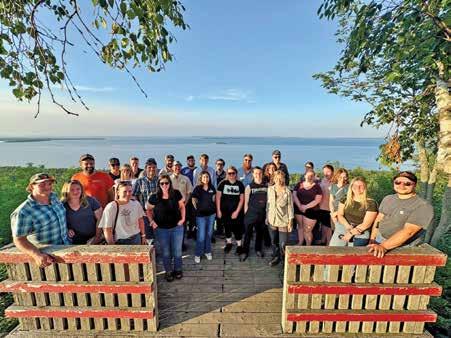
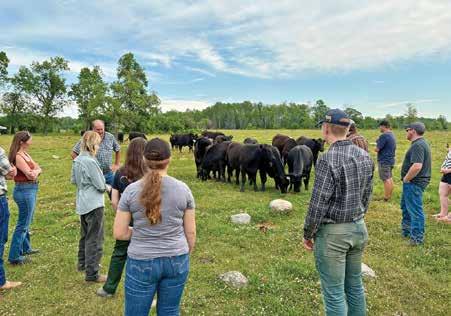
manager Ralph, provided an overview of their operation. Silver Spring Farms is a commercial cow-calf enterprise with a strong focus on developing maternal traits. While their home farm is located near Ravenna in the Blue Mountains area of Grey County, they purchased their first property on Manitoulin Island in 2012. Initially, the island farm was used for pasturing yearlings, but in 2014 they transitioned to a cow-calf operation, with the first herd overwintering there in 2015. In 2024, they expanded further by starting a cash cropping program on the island to produce all of their own feed. Today, the herd consists of commercial Angus and Simmental cows, which calve in April and May in a reclaimed gravel pit. Most of their pastureland is tiled, allowing for effective rotational grazing. Unlike many other areas on the island, water availability is not a concern on the McKinlay’s land.
Our final stop of the day was in Spring Bay for a tour of Sharpe Farm Supplies. Matt Holland guided us through the store and grain elevator, sharing the history of the business along the way. Sharpe Farm Supplies is operated by Paul, John, and Michael Sharpe and was originally founded in 1986 by their parents, Bill and Marion Sharpe, as a retailer of seed, fertilizer, and crop protection products. What began as a small operation in Wellington County has since grown to include locations in Moffat, Freelton, Fergus, Elmira, Guelph, and now Manitoulin Island. Each store is designed to provide farmers with everything they need for a successful operation. Grain handling remains a core part of the business, with two grain elevators located at the Spring Bay site. After the tour, the group enjoyed a supper hosted in the shed, followed by a scenic drive around some of Silver Spring Farms’ land in the area.
The final day of the tour began with a visit to Silver Spring Farms in Mindemoya. Robert and Emily McKinlay, along with their farm
Robert emphasized the importance of soil sampling and thoroughly understanding land potential before purchasing, given the wide variation in land quality across Manitoulin. He credited Ralph for his key role in managing the herd and making their island operation possible. Robert also highlighted the exciting opportunities Manitoulin offers for young producers looking to expand beef production.
The final leg of the journey began with saying goodbye to our bus driver, Bob, before boarding the Chi-Cheemaun ferry for the return trip. We’re happy to report that all 35 participants made it back safely from the island!
We would like to thank all the participants for taking the time to attend the Ontario Beef Youth Alliance Tour and make the journey to Manitoulin Island a success. The farm hosts were incredibly generous to welcome everyone onto their farm and share their management practices. This event would not have been possible without the generosity of the many sponsors – thank you for your continued support and investment in the next generation of the Ontario beef industry. We sincerely appreciate everyone that stepped in to help bring this event together, and are looking forward to next year! OB

AsRESEARCH UPDATE New Report Offers Ontario’s Livestock Industry a Roadmap to Manage New Disease Threats
By Lilian Schaer
new diseases increasingly pose risks to livestock and human health, a report from the University of Guelph’s Food from Thought program offers practical solutions and a clear call to action for Ontario livestock farmers.
Released this spring, Managing Agri-Food Pathogens identifies five key recommendations to help detect, prevent, and control diseases across Canada’s agri-food system. Based on analysis of seven years of research, the report also highlights innovative tools and strategies already making an impact.
Several of the report’s research findings have direct, on-farm relevance in Ontario, offering producers opportunities to reduce risk, lower costs, and respond more effectively to health threats. These include:
• Probiotics to boost vaccine efficacy: Researchers are exploring how targeted probiotics can strengthen gut health and enhance immune response across various livestock and poultry sectors.
• Big data and early warning systems: A real-time decision support system developed by Dr. Rozita Dara and team uses social media, weather, and historical disease data to predict and detect threats before they escalate.
• Wastewater surveillance: Pioneered at Guelph by Dr. Lawrence Goodridge during the COVID-19 pandemic, wastewater testing for tracking diseases has the potential to be adapted to track livestockrelated pathogens — particularly useful in rural or remote communities.
• In-ovo poultry vaccination: Dr. Shayan Sharif and team have developed a breakthrough method to vaccinate chick embryos before hatching, boosting protection against avian influenza and potentially lowering vaccination costs for poultry operations.
Five Recommendations for Livestock Producers
The report outlines five system-wide recommendations to strengthen biosecurity, disease surveillance, and collaboration across Canada. Here’s what they mean for livestock producers in Ontario:
1. Adopt a One Health framework
At the heart of the report is the call to adopt a One Health approach that recognizes the interconnectedness of human, animal, and environmental health. Cross-sector collaboration — linking veterinarians, farmers, ecologists, and public health experts — supports coordinated monitoring of animal health trends and disease risks, and continuous improvement of farm management practices to better prepare for disease outbreaks.
2. Improve livestock immunity through gut health and nutrition
Healthy animals are more resilient to disease. Strengthening livestock immunity through better gut health — supported by tailored nutrition and probiotics — can reduce both disease risks and antibiotic use. Ontario producers are encouraged to review their feeding programs and consult with nutritionists or veterinarians on microbiome-supporting strategies for their livestock and poultry.
3. Invest in vaccines and biosecurity tools
The report highlights the urgent need for new vaccines, diagnostics, and biosecurity technologies. For producers, this means regularly reviewing and updating on-farm biosecurity protocols — such as visitor controls, animal quarantine procedures, and equipment sanitation — and staying current with vaccination programs. Participation in pilot projects and field trials for new tools is also encouraged.
4. Strengthen surveillance and data systems
Simply put, better data means better decisions. The report calls for development of an integrated digital infrastructure that combines health, environmental, and genomic data to enable faster, more accurate responses to threats. Livestock producers can contribute by maintaining health records, using digital tools, and joining datasharing programs. Participation in government or research initiatives can also support sector-wide preparedness.
5. Enhance communication and knowledge sharing
Timely, effective communication between researchers, farmers, industry organizations and partners, veterinarians, and policymakers is essential. Too often, information doesn’t reach farmers in time to act. Producers are encouraged to stay connected through industry organizations, educational events, and trusted agricultural news sources to keep up with the latest developments.
A Clear Call to Action
The Managing Agri-Food Pathogens report is a reminder that Canada’s agri-food system —livestock production included — must stay ahead of emerging threats. This is not just a livestock issue; it’s a cross-sector challenge that spans all species and production systems. Managing agri-food pathogens is critical not only for keeping animals healthy but also for safeguarding human health and ensuring the resilience of our entire food system.
For Ontario’s producers, that means continuing to invest in animal health, adopting strong biosecurity, engaging in disease surveillance, and staying informed about the latest tools and research and embracing adoption of innovation on-farm.
More information, including a link to the full report, is available at foodfromthought.ca OB
Livestock Research Innovation Corporation is funded in part by the Sustainable Canadian Agricultural Partnership (Sustainable CAP), a 5-year, federal-provincial-territorial initiative. Food from Thought is a research program at the University of Guelph funded in part by a grant from the Canada First Research Excellence Fund. This article is provided by LRIC as part of its ongoing efforts to report on research, innovation, and issues affecting the Canadian livestock industry.

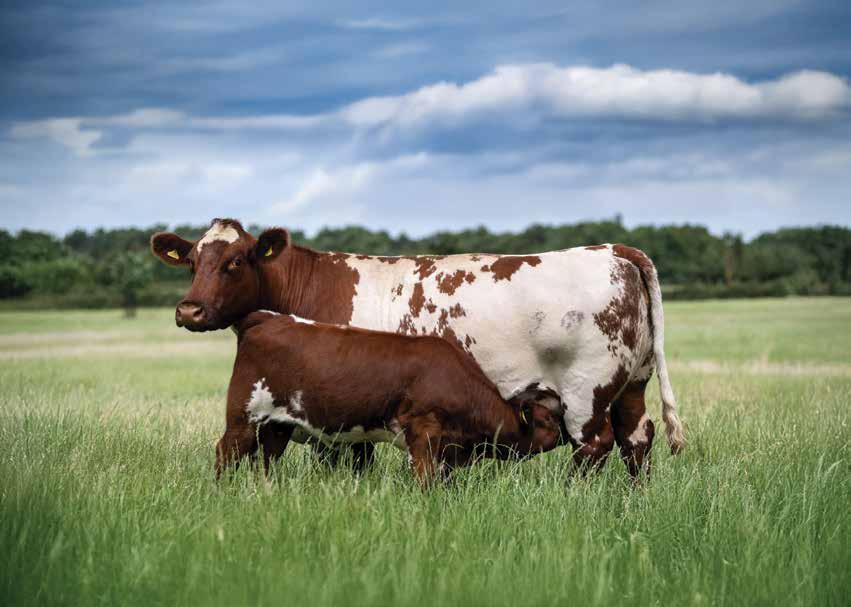

TIBS SHORTHORNS
Pat Thibodeau
Georgetown, ON 416-319-1901 tibsshorthorns@gmail.com
COLDSTREAM FARM
Flesherton,ON
Don Jack: 519-924-1540
Shea O’Neill: 519-373-6599
Heifer, Bulls, Show Prospects Breed Leading EPDs

HOLLAND LANE FARM
Tim & Jocelyn Gilbert & Family
Ross Laycock, Herdsman
Shannon Kingston,Manager 519-477-1526 hockeymama@live.ca
RED ROSE FARM
Martin & Liz Mason & Sons
747710 Twp Rd 4,Drumbo,ON
Cell: 519-771-7066 martin.mason@redrosefarm.com
GLENROTHES FARM
Beaverton,ON
Doug Brown: 905-431-8496
Nancy Brown Andison: 416-817-0369
LOCUSTVIEW SHORTHORNS
Steve, Joyce & Dan Bartlett
Almonte, ON 613-256-3042 locustviewshorts@outlook.com
Frank Byrne, President - 519-809-5853
email: frankiebyrne@live.com
HILL HAVEN FARM
Duntroon,ON
Dale Asser: 705-444-9403
Matt (herdsman): 519-378-5508 hillhavenshorthorns1@gmail.com www.hillhavenshorthorns
MARTIN FARMS
Gore Bay,ON
Jim: 705-348-1294
Nick: 705-348-1022
Alex: 705-782-4725
Bulls, Females, Commercial Cattle
CRAWFDOWN FARMS
Glencoe,ON
Gord & Sally Crawford 519-870-2396
Reed & Jane,Shelby&Josie 519-857-7333
FLIGHTPATH
Caledon,ON
David&Joanne Currie& Family
David: 647-400-2844
Jessica: 519-400-3160 farm. ightpath@gmail.com
OMAFA Funding Helping to Drive Agricultural Advocacy Initiatives
Earlierthis summer, Farm & Food Care Ontario (FFCO) was pleased to announce a three-year funding agreement with the Ontario Ministry of Agriculture, Food and Agribusiness (OMAFA). Through this agreement, up to $597,000 will be invested in FFCO’s outreach initiatives over the next three years. This funding is key in enhancing FFCO’s ability to expand its programming and connect with a broader audience across Ontario and beyond.
This funding is already at work supporting FFCO’s 2025 programs, including increasing the organization’s ability to highlight beef farming and the people behind it through expanded storytelling and engagement opportunities. As a platinum member of FFCO, Beef Farmers of Ontario (BFO) plays a key role in this work, helping ensure accurate and engaging information about Ontario beef reaches nonfarming audiences.
This funding is already hard at work supporting FFCO’s programs in 2025 including:
Breakfast on the Farm - The first of three annual events took place on June 14 at Hoenhorst Farms in Innerkip, welcoming 2,200 guests, including visitors from as far away as Toronto. More than 200 farmers and agri-food industry members volunteered, contributing to the day’s success. The livestock exhibits featured beef cattle provided by the Pletsch family, with representatives from BFO on hand to answer questions and engage guests in conversations about Ontario’s beef industry.
Food industry professional outreach - Farm tours are a cornerstone of Farm & Food Care Ontario’s efforts to provide


We will have a few females in the Blue Water Sale on October 18 at Cargill Ont.
The bull calves are looking good and genomically tested either 9 or 10 for tenderness.
Now is the time to reserve your bulls for 2026.
Commitment to quality, and multi trait focus, results in world class genetics. No one ever regretted buying quality.
DON & JEANNETTE CURRIE
2234 Conc. 11, R R #1, Nottawa, Ontario L0M 1P0
Phone/Fax: 705-445-1526
Cell: 705-715-2234 • Email: doncurrie@glenislay.com

credible, firsthand information about food and farming. Designed to bust myths and build relationships, the tours connect key target audiences—including media, dietitians, culinary students, and other food professionals—with Ontario farmers, helping them understand how food is grown and produced. Held near major centres like Toronto and Ottawa, the tours minimize travel time and maximize on-farm learning, featuring a variety of commodities and expert insights. Participants leave better equipped to answer questions about agriculture and food production, fostering longterm trust and appreciation for Canadian farming. The first of seven 2025 farm tours took place on June 20, bringing Toronto-area food industry professionals to multiple farms in Perth County, with six more tours scheduled for the fall.
Resource and Signage Lending Library - FFCO’s library of customizable and lendable resources supports agricultural education at fairs and public events across Ontario, helping deliver accurate, engaging information to a wide range of audiences. The collection includes farm fact signs and display materials as well as the FarmFood360 virtual reality kiosk which features virtual tours of two Ontario beef farms. Along with print items like The Real Dirt on Farming, colouring books, and activity posters, these tools help create meaningful connections between farmers and the public. Resources can be borrowed, rented, or purchased, with a full list available at FarmFoodCareOn.org.
Digital outreach and downloadable library - FFCO’s digital asset library, developed for Ontario’s Local Food Week, features 64 social media graphics designed for industry partners, generating over 900 downloads. Local Food Week had a combined media and social reach of 6.6 million. A general social media kit is also available at FarmFoodCareON.org, with new assets for Ontario Agriculture Week launching this fall. Continuously expanding, the library provides accessible, ready-to-use tools that support the agri-food industry in engaging the public and advancing conversations about food and farming.
Training for farmers and agri-food professionals - FFCO offers a range of training and speaking services designed to build confidence, communication skills, and advocacy in the agri-food sector. Programs include media training, Speak Up advocacy workshops, social media training, Good Boothmanship, and Ag 101 sessions for those new to the industry. So far in 2025, FFCO has numerous topic-specific presentations—equipping beef farmers and others across the province with tools to effectively engage non-farming audiences. All training opportunities are available by request.
FFCO remains committed to developing new tools and resources that help Ontarians better understand how their food is produced, with a focus on showcasing Ontario’s exceptional beef industry. The goal is to foster a stronger connection between the public and the province’s dedicated beef farming families, building confidence that farmers are producing safe, healthy, affordable, and sustainable food every day of the year.
For more information about FFCO’s initiatives, visit www.farmfoodcareon.org OB

Beef Farmers Return to Queen’s Park Leading into Ontario’s Local Food Week
The Beef Farmers of Ontario (BFO) returned to Queen’s Park in May to host their highly anticipated annual barbecue and lobby day on the lawn of the Ontario Legislature, and just prior to Ontario’s Local Food Week, which takes place the first week of June and celebrates the abundance of food grown by Ontario farmers. The BFO Board of Directors and staff proudly served over 500 attendees an all-Ontario meal featuring Ontario Corn Fed Beef and fresh salads.
Beyond hosting the barbecue, BFO Directors and staff personally met with numerous MPPs throughout the day to highlight key priorities of Ontario’s beef sector. These discussions focused on how farmers and government leaders can work together to ensure the sector’s sustainability through strategic investments and sound policies that safeguard farmers’ financial health and create opportunities for agricultural growth.
BFO wishes to thank Premier Ford for taking the time to meet with our team, and to Trevor Jones, Minister of Agriculture, Food and Agribusiness; and MPP Bill Rosenberg and MPP Paul Vickers, Parliamentary Assistants to the Minister of Agriculture, Food and Agribusiness, for generously taking time to serve beef to the barbecue attendees. BFO also appreciated the participation of NDP Leader Marit Stiles and MPP John Vanthof, NDP Agriculture Critic, as well as Green Party Leader Mike Schreiner who all helped to serve beef during lunch. OB




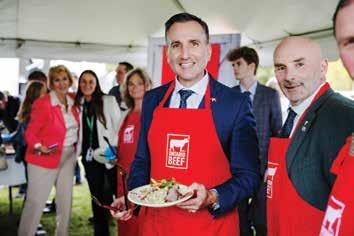
BFO directors and staff met with Minister Rob Flack.
BFO appreciated Premier Ford taking the time to meet with the board and his help to serve beef during the barbecue.
BFO directors and staff met with Minister Lisa Thompson.
Trevor Jones, Minister of Agriculture, Food and Agribusiness helped to serve beef with Premier Ford.
Green Party Leader Mike Schreiner met with BFO directors and staff during the day, and helped to serve beef.

BFO directors and staff met with Ontario’s Attorney General Doug Downey. BFO
Green Party
Mike Schreiner.

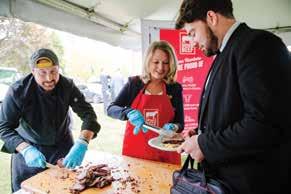





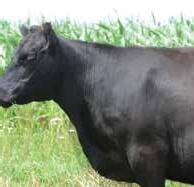


BFO directors and staff met with Kristyn Wong-Tam from the riding of Toronto Centre.
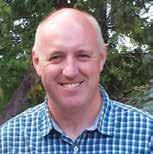
ForOMAFA UPDATE
The Benefits of Leader-Follower Grazing Systems
By James Byrne, Beef Cattle Specialist, OMAFA
spring-calving beef cows, milk production gradually declines from month two of lactation onwards. As milk production declines, calf milk consumption as a per cent of their total diet also declines as the calf transitions to consume more pasture. From three to four months onwards, solid feed makes up more than 50 per cent of calf dry matter intake. Like all young animals, calves are selective grazers, choosing only the most palatable, nutrient-rich young grass leaves - those highest in energy and protein. Unfortunately, this peak demand for high-quality forage often coincides with a seasonal decline in its availability. This mismatch can negatively affect calf growth and performance, potentially leading to lower weaning weights and reduced returns at the sale barn.
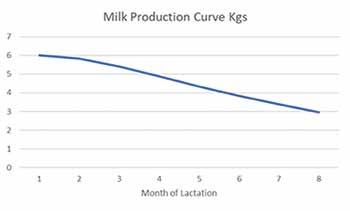


One option to help alleviate this issue is to implement a leaderfollower grazing system. In this type of system, calves are allowed to graze ahead of the beef cows. This gives calves access to high quality pasture and allows the cows to follow behind to graze out the more mature pasture. The most common way to do this is to use electrical wires to allow younger animals to access the grazing area while keeping larger animals out. In this method, an electric wire is strung so that it is only high enough to allow calves to pass under but not so high as to allow other animals under. The wire fence is then moved along to give the calves continuous access to high quality pasture and allow the beef cows to clean up behind them.
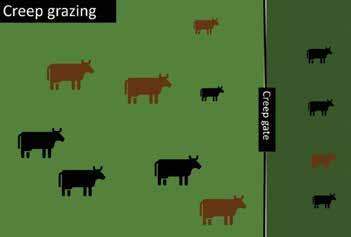
Another method is to use a creep gate (Figure 3). A creep gate, often called a forward creep gate, is a gate placed in the fence line where the bars of the gate are only wide enough to allow calves to pass through, but not larger animals. Creep gates work well where the farm is set up with numerous small paddocks, and it would not be practical to split paddocks using an electric wire. Once set up, creep gates can be a permanent fixture, so there is less labour involved compared to continuously moving an electric fence. However, an electric fence is a relatively cheap option, and is very flexible. Leader-follower grazing systems offer significant benefits. Calves gain additional weight by accessing higher-quality forage ahead of the main herd, resulting in heavier weaning weights. These systems also help calves become more independent, making the weaning process less stressful. When creep gates are used, weaning can be as
Continued on page 20.
Figure 1: Typical Beef Cow Lactation Curve, kgs Milk
Figure 2: Typical DMI, lb/Day from Birth to Weaning
Figure 3: Visual of Creep Grazing - Reproduced from Grazing Management Concepts and Strategies, Alabama A & M and Auburn Universities Extension, 2021
The Angus Advantage
Ontario farmers know Angus cattle are low-maintenance, adaptable, resistant to harsh weather, undemanding, good natured, mature early and have a high carcass yield with marbled meat. Canadian Angus cattle work well in both purebred and commercial operations. Their docile nature makes them unrivaled leaders in the beef industry.
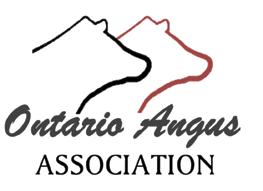
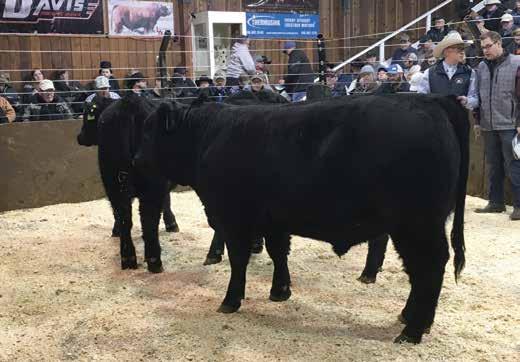
Visit the Ontario Angus Association website for more information and to find listings of Ontario purebred sales: www.cdnangus.ca/ontario-angus-association
Contact any of the breeders below to arrange for your private viewing of cattle for sale.
Cairnlee Acres
Victor, Yvonne & Andrew Richardson 6193 Walkers Dr, Strathroy, ON Vic Cell: (519) 871-4240
Cambray Livestock Company
Luke, Matt, Joe and Carl Jewell 1153 The Glen Road, Woodville ON 705-934-2853
Fallis Land and Cattle
Mike, Lisa and Cole Fallis 1273 6th Line, Selwyn, ON K9J 6X5 705-740-4878 | sunsetacres@nexicom.net
Gilchrist Farms
Brad & Kristie Gilchrist 1269 Grey Ox Ave RR#5 Lucknow, ON N0G 2H0 519-440-6720 | brad@gilchristfarms.com
Glen Islay Angus
Don Currie
2234 Conc 11, Nottawa, ON L0M1P0 705-715-2234 | doncurrie@glenislay.com
Loval Farms
Scott & Sandra Honey 127 Honey Road, Warkworth, ON K0K 3K0 705-924-3809 | lovalfarms@gmail.com
Harprey Farms
Allan Hargrave/Don Hargrave 307483 Centre Line A Proton Station, ON N0C 1L0 Allan 519-375-5541 | Don 519-375-1500 harprey@gmail.com
Maple Line Farm
Ian & Tim Rudkin 3320 Bradburn Road, Blackstock, On L0B 1B0 Ian 905-718-5331 | Tim 905-213-6518 maplelinefarm@hotmail.com
Meadow Bridge Angus
JJ Deslippe
922580 Rd 92 RR # 4, St Mary’s, ON N4X 1C7 519-275-1739 | meadowbridge14@gmail.com
Rob Roy Angus
Don & Betty McNalty 634514 Road 63 RR#2
Singhampton, ON N0C 1M0 705-446-4740 | robroyangus@gmail.com
SCOMAC Livestock
Scott & Elizabeth MacDonald 4169 Highway # 6
Hagersville, ON N0A 1H0 Scott 519-820-1272 | Elizabeth 226-971-0015 scomaclivestock@gmail.com
Silver Springs Farm
James, Joan, Robert and Emily McKinlay 609027 12th Sideroad RR#1 Ravenna, ON N0H 2E0 519-599-6236 | jmckinlay@bmts.com
Tullamore Farms
Bill & Sylvia Jackson 260 Regional RD 39 Zephyr, ON L0E 1T0 Cell 647-990-2697 tullamore.angus@gmail.com
Whiskey Lane Livestock
Scott, Paula, Jason & Shelby Cornish 2295 Hwy 7, Indian River, ON K0L 2B0 705-341-3220 | wll@nexicom.net
Windcroft Farms
Darcy & Courtney McMorris 573333 Boot Jack Ranch Road
Priceville, ON N0C 1K0
226-203-4506 | windcroftfarms@gmail.com
Worth-Mor Cattle
Kyle, Rachel, Jordyn and Mason Petherick 950 County Rd 8
Campbellford, ON K0L 1L0
705-768-3560 | worth-mor@hotmail.com
simple as closing the gate to prevent calves from returning to their mothers.
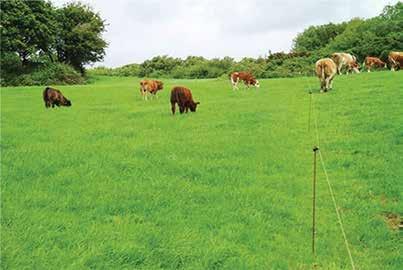
Proper set-up is crucial for the success of a leader-follower system. Calves need to be trained on how to graze ahead of their mothers. To do this, set up a small area in the existing paddock where calves can enter but easily run back to their mothers. Once calves have gotten settled in this area and are happy to spend time away from their mothers, the area ahead of the calves can be increased to the desired area. If electric polywire is to be used to separate cows from calves, ensure that there is adequate power in the wire to prevent cows from simply walking through it. The wire should be checked to be free of vegetation that would impact its effectiveness. If creep feeding is planned, ensure there is enough trough space that calves can all feed at the same time. At weaning, the electric wire can be lowered, or creep gate closed to prevent calves having access to their mothers for longer periods of time before being allowed back to suckle. At the time of weaning, calf access to their mothers can be closed off completely.
Leader-follower grazing systems give calves access to high quality forage which should deliver good performance without the need for supplementary feeding. This is also a great opportunity to introduce creep feeding to deliver more gain, but also to help bunk train calves before weaning. Bunk trained calves are less stressed at weaning, recover quickly from the weaning process and are desired by feedlot buyers at the sale barn. The big advantage of creep feeding in a leader-follower system is that it is easier to control creep intake as there is no need for complicated equipment that allows calves access to creep but prevents access by beef cows. It’s easier to do this when a creep gate is used, as a simple electric fence may not be enough of a deterrent for a beef cow that really wants to get access to the grain her calf is consuming.
An additional benefit of leader-follower systems is that during periods of drought, the pasture that’s available can be dedicated towards younger animals to maintain their performance, while limiting the need to feed hay or other saved forage to beef cows. Calf demand for pasture is low compared to a mature beef cow and this can be managed further by adding creep feed to the diet. This way, the demand for pasture can be controlled for that period when grass growth is either very poor or non-existent.
Leader-follower systems do not need to be exclusively tied to grass pasture. They can be used very successfully when grazing alternative forages where calves are given access to the earliest growth stage, which has the highest potential performance ability with cows following up behind as the forage matures. On some farms, producers allow calves to forward graze on small grain cereals while cows have access to medium quality grass pasture. This only works well where the area of the small grain cereals is adjacent to the grass pasture so that calves can easily return to their mothers to suckle.
Research on the performance benefits of leader-follower systems is patchy and inconclusive. Research by Kyne et al, (2001), showed that the performance difference from leader-follower systems compared to leaving calves to graze with their mothers was only evident where the pasture ahead was of a superior quality to the existing pasture. While forward-grazed calves gained more weight during the grazing phase and were heavier at weaning, they weighed the same at the end of the winter-feeding period as calves that were not forward-grazed. This was due to higher daily gains in the non-forward-grazed group during the winter, demonstrating calves’ ability for compensatory growth, a biological response producers can leverage to achieve costeffective weight gains.
Overall, leader-follower grazing systems are a great way to drive good calf performance, achieve good weaning weights, allow easier and cheaper delivery of creep feed, manage cattle and pasture during periods of drought and make the weaning process a significantly less stressful event. Set up and management is relatively easy and does not have to be expensive.
References available upon request. OB
Figure 4: Tall electric fence allows calves to graze high quality pasture separately from cows but still allow access to suckle. Reproduced from Watch: Letting calves creep forward to maximise performance. Source - www.farmersjournal.ie
CHAROLAIS SALE
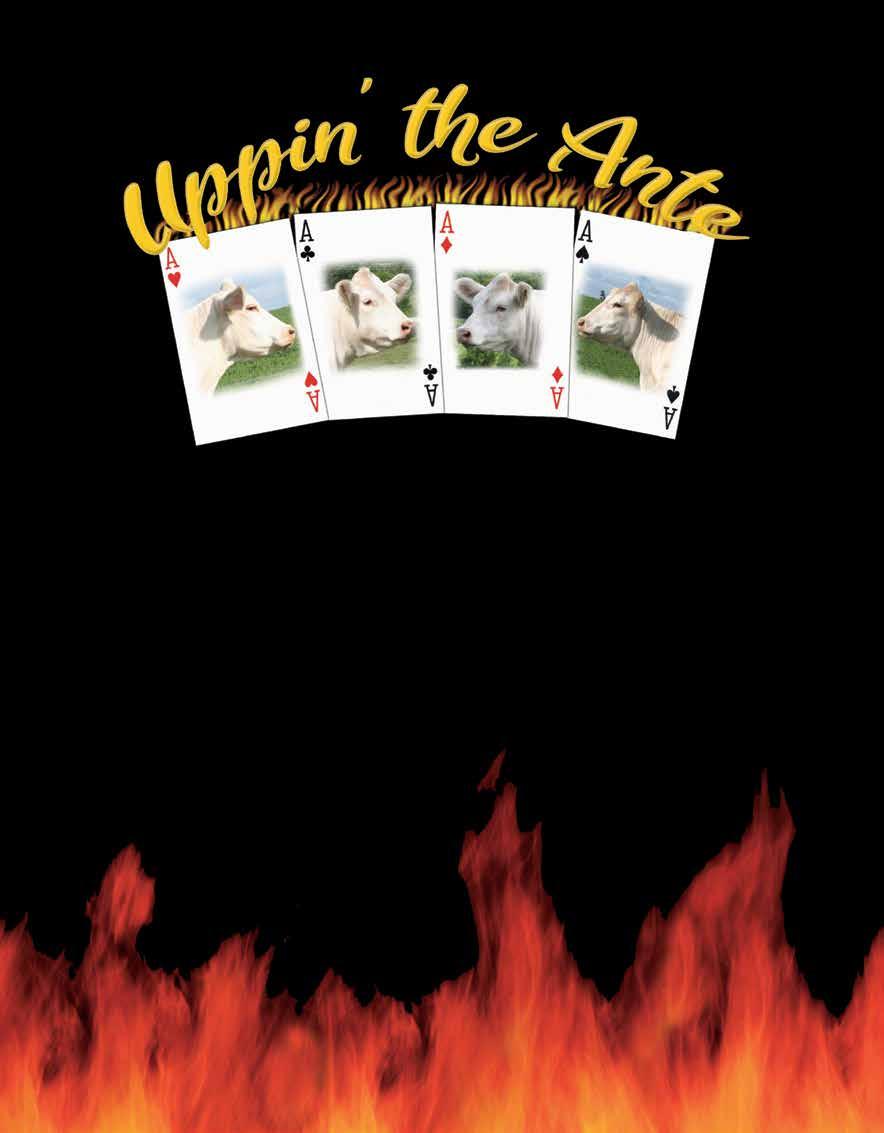
Cash incentive program for a project animal purchased from the Uppin’ the Ante Female Sale
• $500 to the Grand Champion at the CCYA National Junior Show
• $500 to the Supreme Champion at the Canadian Junior Beef Show (Royal Winter Fair)
• $250 to the Reserve Grand Champion at the CCYA National Junior Show
• $250 to the Overall Grand Champion at the Junior Exhibitor’s Regional 4-H Show
• $100 for the completion of the 4-H project
SCHEDULE
THURSDAY, OCTOBER 17 – Viewing of the cattle all day followed by a social in the evening
FRIDAY, OCTOBER 18 – Viewing of the cattle all day, supper and refreshments begin at 5:00 p.m. and run until

From Barn Design to Bunk Management: Producers Gather for Feedlot Management School
By Jaclyn Horenberg, BFO Manager of Producer Relations
Over100 producers welcomed the return of the Feedlot Management School hosted by the Beef Farmers of Ontario (BFO) and the Ontario Cattle Feeders’ Association (OCFA) on June 18th and 19th in Bruce County. Registration spaces filled up quickly, and sponsors were keen to support the tour - filling an additional 17 spaces on the two-day event.
The tour kicked off at Bennett & Sons Farms Ltd., near Gorrie. Bob Bennett welcomed producers to their newest barn on their third-generation operation where they have the feeding capacity for 6,000 head of finished beef cattle and 8,500 hogs. Bob explained that they farm on multiple site locations while cropping over 6,000 acres, as a source of feed for their livestock. Bob chatted with the group about their newest barn design and the process of upgrading their facilities. Bennett’s are proud to be founding members of the Ontario Corn Fed Beef Program, and they’re certified with the Canadian Roundtable for Sustainable Beef (CRSB). Both Bob and his dad, Ron, have been actively involved in committees and organizations in the beef industry for many years. They emphasized the importance of getting involved to help drive progress in the sector.
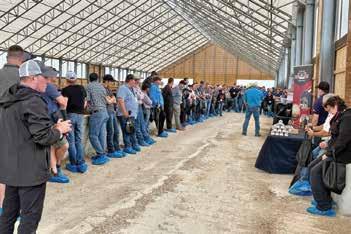
The convoy then travelled to the Schaus PKW Yard near Walkerton. Ken Schaus welcomed everyone to the farm, and explained that his father, Wally, founded the Schaus Group in 1971. The operation

has greatly expanded over the years, and Ken acknowledged their dedicated and hardworking team for helping to make that possible. The group was divided into two to travel through the impressive operation. Group one started with Ken and Dr. Jacques van Zyl from Metzger Veterinary Services, where they discussed how they keep the pens full and the cattle performing. Ken shared his cattle procurement strategy, and what he looks for when sourcing cattle. He emphasized the importance of working with quality trucking companies who prioritize cattle comfort during transport. Low stress cattle handling is paramount when receiving cattle into the yard and during processing. Ken touched on the value of data collection and using that information to make good management decisions. Dr. van Zyl discussed receiving protocols and risk assessment on cattle coming into the feedlot.
The second session featured barn manager TaDomi Hunt and Dan Bears from Cargill Animal Nutrition who spoke about getting cattle off to the right start. Dan shared the nutrition program and the importance of following a receiving protocol when bringing in calves or grass yearlings. He emphasized the importance of consistent management when stepping cattle up onto feed, and assessing the risk status of those cattle before arrival. TaDomi explained their feed and bunk management strategies, and participants were able to see the Juno automatic feed pushers in action enticing cattle to the bunk. Throughout the visit, they emphasized the importance of having a strong team that communicates well and strives for continuous improvement.
To conclude the first day, the group enjoyed an evening reception at the Best Western in Walkerton. John Baker, Director of the Ontario Beef Market Development Program, spoke about competitiveness through differentiation, and the value of expanding export markets for Ontario beef. He reassured producers that when his team is marketing beef, they’re focused on efficiency and carcass utilization just as much as producers are focused on finding efficiencies at the farm level. John explained the model of circularity in beef production and the importance of telling the positive story of how beef cattle are raised right here in Ontario.
During the evening reception, BFO Executive Director, Richard Horne, and OCFA President, Al Noorloos both brought greetings, and the generous sponsors were acknowledged for their contributions and support for the event and its attendees.
The next day began with rainy weather and construction at every corner as the buses navigated their way to Eby Farms in Kincardine. Steve welcomed the group to his feedlot operation where he and his dad, Stan, market 1,200 head of cattle per year. Both Stan and Steve are active volunteers who have committed many years to involvement within the Canadian beef industry. Stan previously served as CCA and OCA (BFO) President and he’s a recent inductee into the Canadian Agriculture Hall of Fame, and Steve is a past BFO Director, BFO Feedlot Committee member, and previous Chair of the Feeder Finance Executive Committee, just to name a few. Steve emphasized the value of continuous improvement and getting involved in the industry to learn from each other. The Eby’s value quality assurance

and their feedlot is CRSB Certified through the Verified Beef Production Plus program.
Guest speakers, Ashley Knapton from Leeder Agriservices Inc., and Rebecca Miller, Pioneer Representative with Edgar’s Feed & Seed joined us on Steve’s farm to discuss inoculants and bunk management. They shared best management practices when packing bunks and how to maintain the integrity and nutritional value of the feed, along with the inoculant products available. Tim Prior and Melissa Veldman from Brussels Agri Services Ltd., also joined us to discuss the impending CFIA traceability regulations, and the tools available to help prepare the beef sector for new requirements. They demonstrated the Gallagher tag readers that are available in the marketplace and how they can be used to manage individual animal data along with the ability to seamlessly enter move-in data to the Canadian Livestock Tracking System.
The final stop on the tour brought us to Ellengowan Farms in Paisley where we were welcomed by Jairus and Becky Maus. We began in their new barn with a delicious lunch featuring Ellengowan beef catered by Harleys Pub & Perk from Mildmay. Jairus provided a tour of their operation where they background and finish over 3,000 head per year, farm over 2,500 acres, and operate a 300,000 bushel on-farm storage and elevator facility. Jairus spoke openly about the advantages and disadvantages of their barn designs and layouts. As a strong supporter of tools to help manage risk, Jairus spoke about the value of Ontario’s Risk Management Program and the Feeder Cattle Loan Guarantee Program. He also shared his honest thoughts about the challenges they face on their operation, and the hope that he has for the next generation in the beef sector. Jairus explained his involvement as a BFO Director and being the Ontario representative to the National Cattle Feeders’ Association. Ellengowan Farms is CRSB Certified through the Ontario Corn Fed Beef Program.

Joining us at Ellengowan Farms, was Jarrett Johnson, owner of B&L Farm Services, who spoke about Performance Beef Analytics and how it can be used to help measure and manage performance on beef operations. Jarrett explained how the program works and the value of having real-time data to make decisions. We also had a discussion about the new CFIA feed regulations, which came into force on June 17th, requiring producers who mix medicated feed on farm to have a preventative control plan (PCP). Jaclyn Horenberg shared that BFO is actively working with NCFA, VBP+, and OCFA to develop a PCP template to assist producers with compliance. Jaclyn and Chelsea Martin from OCFA, shared that producers who are certified through either VBP+ or the Ontario Corn Fed Beef Program, will already be doing the preventative measures asked for in the PCP, but it will still need to be documented to be in compliance. Producers were assured that more details would be forthcoming as the template was developed. We concluded the tour with a final thank you to all farm hosts, sponsors and participants before heading on the bus back to Walkerton.
On behalf of BFO and OCFA, we would like to thank all the participants for taking the time to attend the Feedlot Management School. The farm hosts were incredibly generous to welcome producers to their farm, and to share their production practices and hospitality. Thank you to the speakers for sharing their knowledge and expertise. This event would not have been possible without the generosity of the many sponsors who continue to invest in Ontario’s beef sector. We sincerely appreciate everyone who stepped in to help bring this event together; it is another great reminder of what a wonderful industry we are a part of! OB

Use BCMPLUS before, during and after calving season to maximize health and reproductive performance.
BCMPLUS cow mineral aids in reproduction and fetal development by providing essential nutrients through the pre and post partum and nursing periods.
Contact your JFM Beef Sales Consultant to learn more about the advantages of BCMPLUS.

















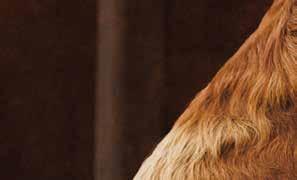









RESEARCH ROUNDUP Understanding Yardage Costs in Cow-Calf Operations
By Beef Cattle Research Council
Have you ever wondered where your money goes during the winter-feeding period? Feed costs are easy to spot in a beef cattle operation, but what about the other expenses quietly chipping away at your bottom line? This is where yardage comes in - it is a crucial part of managing winter feeding costs in cow-calf operations.
What is Yardage?
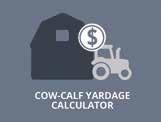
Keeping Track of Yardage
Accurate yardage calculations start with diligent record-keeping. Keep detailed records of cash expenses, such as utility bills, equipment maintenance costs and labour hours.
Many overhead costs are incurred at the whole-farm level, making it necessary to allocate these costs across different enterprises and production stages to calculate yardage accurately.
Overhead costs include machinery maintenance and repairs, building repairs, utilities, insurance, property taxes and salaries.
Yardage, typically expressed on a per-head per day basis, refers to the overhead and non-feed costs incurred while maintaining cattle during the winter-feeding period. These costs include day-to-day expenses such as labour, equipment and infrastructure maintenance, fuel, utilities, manure handling and other general expenses like farm taxes and accounting fees. They also include non-cash costs such as machinery and facility depreciation, which represent the graduate loss of value in assets over time.
Yardage may not grab attention like feed costs, but it significantly impacts profitability. These costs, especially non-cash costs like depreciation, often remain unnoticed but can erode profitability over time. For example, underestimating yardage may lead a beef producer to assume their operation is more efficient than it truly is. Ignoring yardage also makes it difficult to identify areas where costs can be optimized. For example, the exclusion of machinery maintenance and repair costs may make the cow-calf enterprise look more profitable than it is.
Using Yardage Insights for Better Decision-Making
Yardage is more than just a line on a spreadsheet - it’s a key component to understanding and controlling costs and can be a powerful tool for improving financial outcomes. Here are some examples:
• Pinpoint cost driver: Identify the most significant contributors to yardage and pinpoint opportunities for savings.
• Evaluate resource utilization: Determine if equipment and facilities are underutilized or can be used for other farm tasks.
• Explore alternatives: Yardage insights can highlight opportunities to lower non-feed costs through alternative feeding methods.
• Assess economies of scale: Knowing yardage costs can help assess whether expanding the herd could lower costs per head. Overhead costs are often considered fixed because they don’t change significantly with the size of the herd, up to a point. This means that increasing the herd size can spread these costs over more animals, reducing the per-unit expense and improving cost efficiency. However, as the herd grows beyond the capacity of existing resources, additional expenses for equipment or labour may arise.
For farms with multiple enterprises (e.g., cash crops and cattle), allocating whole-farm costs to the cow-calf winter-feeding period can be complex but essential. Various methods can be used for this allocation:
• Time-based allocation: For assets like machinery or facilities, costs can be divided based on the proportion of time these resources are used for winter feeding.
• Revenue-based allocation: It can be difficult to track or estimate the use-time of each fixed asset used on a diversified farm. In this case, costs can be divided based on the cow-calf enterprise’s share of total farm revenue. For instance, if the cow-calf enterprise generates $40,000 in revenue and the crop enterprise generates $60,000, the total farm revenue is $100,000. The cow-calf enterprise’s share is 40 per cent, so 40 per cent of overhead costs would be allocated to it.
• Alternative methods: Costs can also be allocated using the percentage of gross margin or total expenses contributed by each enterprise. For example, if the cow-calf enterprise incurs 45 per cent of the total farm expenses, 45 per cent of the overhead costs would be allocated to it.
BCRC Cow-Calf Yardage Calculator
The Cow-Calf Yardage Calculator is designed to help producers estimate their yardage by providing a clear template and streamlining the calculation process. It requires data input on herd size, winter feeding days, whole-farm cash overhead costs and the values of machinery and buildings allocated to the cow-calf winter-feeding period. This tool calculates the total yardage cost, including a breakdown of cash expenses and depreciation on machinery and buildings.
While yardage is commonly expressed on a per-head per-day basis, the calculator also provides results in cost per Animal Unit Day (AUD) when animal weights are entered. Production cost and feeding capacity can vary significantly with animal size. Yardage on a per AUD basis helps allocate overhead cost or shared resources based on cattle size or type. This approach is useful when calculating

Continued on page 28.


2025 Fall Sales
Ontario Autumn Simmental Classic - September 13, Hanover, ON
Ontario Simmental Solution Sale - October 4, Staffa, ON
Futures One Simmental Sale - October 4, Staffa, ON
IRCC Quality Control IX Female Sale - October 5, Indian River, ON
Koyle/Stewart/Miller 3rd Annual Online Sale - October 6, Iona Station, ON
Stars of the Valley Simmental Sale - October 18, Metcalfe, ON
RPCC & Guests Fall Gala Sale - October 19, Glencoe, ON
Leahy Livestock Select Bull & Female Sale - October 26, Indian River, ON
Dudgeon Cattle Co & Guests Top Cut Bred Heifer Sale - November 1, Hanover, ON
Premier & Guests Falls View Production Sale - December 30, Toronto, ON
Check out these sales for your next Simmental or Simmental Influenced female. Remember purchasing a registered Simmental from an OSA member enters you into a draw for one of 6 chances of winning $500!
profits, as both costs and revenue can vary with cattle size and type. For example, a larger 1,500-lb cow may have a higher yardage cost, but could also wean a heavier calf compared to a smaller 1,300-lb cow. Calculating yardage per AUD also provides a standardized measure for comparing costs across farms with different herd compositions or within the same farm as herd composition or cattle size shift over time.
Bottom Line
Understanding yardage is vital for identifying inefficiencies, managing resources and improving profitability. By tracking yardage, producers can better navigate challenges and create opportunities for growth. OB
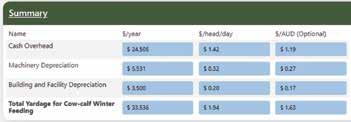
Example summary of yardage for cow-calf winter feeding on a per-year, per-head per-day, and per-animal-unit-day basis
The Beef Cattle Research Council (BCRC) is Canada’s national industry-led funding agency for beef, cattle and forage research. The BCRC’s mandate is to determine research and development priorities for the Canadian beef cattle industry and to administer Canadian Beef Cattle Check-Off funds allocated to research. Visit www.BeefResearch.ca to learn more.
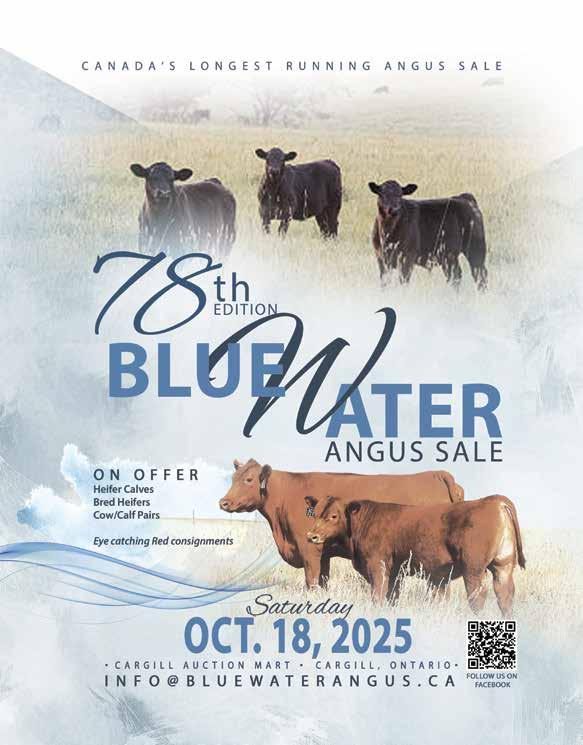
Confessions of a Canadian Beef Farmer Campaign Wraps with Strong Results
By CCA’s Public and Stakeholder Engagement Staff
Asuccessful six-week digital sustainability campaign highlighting the Canadian beef sector’s environmental sustainability progress wrapped at the beginning of May. The publicfocused campaign entitled “Confessions of a Canadian beef farmer”, was delivered in partnership by the Canadian Roundtable for Sustainable Beef (CRSB), Canada Beef, and the Public and Stakeholder Engagement Program (PSE). The partnership allowed for combining of funds and resources for a more impactful, wider-reaching campaign.
“Confessions of a Canadian beef farmer” centered around a lead story video and three extension videos, each of which built on the lead with concrete examples of sustainability progress based on key messages shown to resonate through consumer message testing. The key messages leveraged data and information from the CRSB’s National Beef Sustainability Assessment (NBSA).
Messages included:
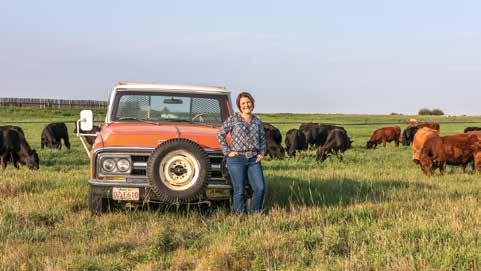
• Carbon Under Cover - Land used for raising beef cattle in Canada helps to store 1.9 billion tonnes of soil organic carbon. That’s the equivalent of taking two billion cars off the road for an entire year!
In addition to digital advertising, an updated Benchmarks webpage on the CRSB site was created and served as a campaign landing page. Here you can see all campaign videos, as well as source reports and scientific assessments from the NBSA. Scan the QR code to be brought to this webpage. OB






MarketCANADA BEEF UPDATE Canada Beef Champions Global Growth This Summer
By Gina Teel, Director, Stakeholder Communications, Canada Beef
diversification remained a top priority for Canada Beef this summer as the team participated in several market development initiatives and opportunities.
Canada Beef hosted Agriculture and Agri-Food Canada (AAFC) Minister Heath MacDonald and Canadian beef industry leaders, along with Canadian beef buyers and importers from Vietnam, Singapore and the Philippines at the Canadian Beef Centre of Excellence (CBCE) in Calgary. The July event, held during the 2025 Calgary Stampede, proved an excellent opportunity to discuss growing beef exports into Southeast Asia. Minister MacDonald participated in a Canadian beef cooking demonstration at the Centre, where the visiting group learned about the quality attributes of grain-finished Canadian beef.
The Canadian beef buyers also toured a beef processing plant, feedlot and cow-calf breeding ranch with Canada Beef Vice President, Export Market Development, Albert Eringfeld.
Canada Beef representatives including President Eric Bienvenue attended the Alberta Beef Industry Stampede Summit, the Calgary Stampede Agriculture and Agri-Food Reception, the Alberta Agriculture Minister Reception, and a networking event at the Philippines Consulate General in Calgary, among others.
Later in July, Bienvenue travelled to Indonesia where Canada Beef exhibited at the Food and Hospitality Indonesia 2025 and then Vietnam to participate in market development meetings and initiatives with local partners. In August, Bienvenue headed to Singapore to join AAFC Minister MacDonald’s agriculture trade mission and meetings with local importers.
Eringfeld participated in Canada Beef’s exhibition at WOFEX and AAFC Minister MacDonald’s trade mission in the Philippines in early August. He will next join Canada Beef’s exhibition at ANUGA in Germany (October) and Canadian beef demand building events in the Gulf region (also in October). Additional demand building seminars in Canada Beef’s key emerging Southeast Asian markets are in the process of development for the first quarter of 2026.
Canada Beef is a proud supporter of agricultural exhibitions across the nation that bridge the urban-rural divide though awareness building and information sharing. The Calgary Stampede is one such event, and Canada Beef made the most of the opportunity to make an impression during the 10-day event which drew more than 1.47 million visitors.
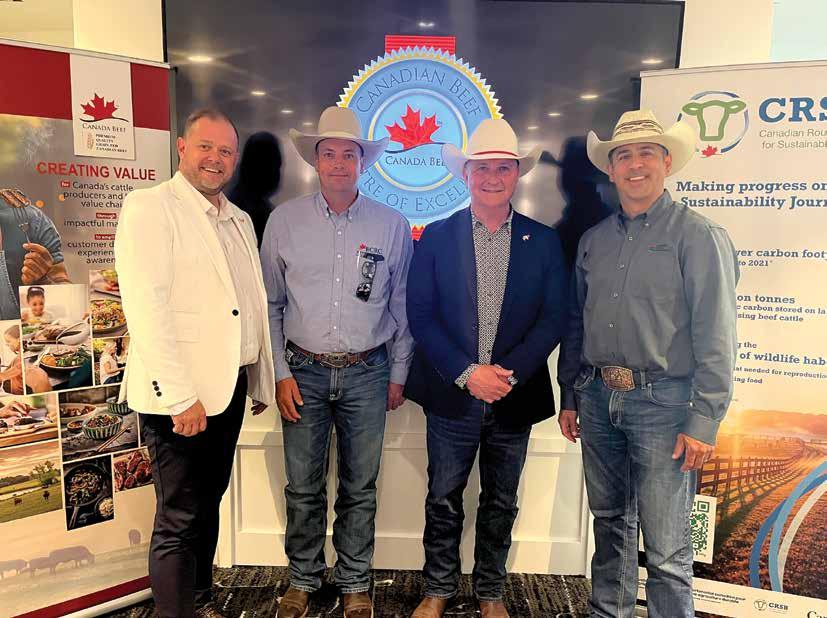
For the second consecutive year, the team at Canada Beef operated a booth in The Market in the BMO during the Stampede.
The Canada Beef booth featured a vast range of resources and information on Canadian beef, buying local, sustainable beef production and the nutritional benefits of beef to human health. Engaging displays on a range of topics— from nutrition and the Canadian Beef Advantage to an interactive kiosk that highlighted the Canadian Beef Information Gateway (Gateway) website.
Further engagement was achieved with the ‘Beef for a Year’ contest, with the equivalent prize of two steaks a week for 52 weeks valued at $2,600, a prize wheel where visitors could spin to win Canadian beef-themed prizes, as well as puzzles and activities for the kids.

Canada Beef and Alberta Beef Producers (ABP) held a joint celebrity-cook off in the Calgary Stampede Kitchen Theatre. The cook-off event was held in front of a live audience, who learned about the quality attributes of Canadian beef and sustainable aspects of beef production in Alberta and Canada, and ultimately decided the victor via a taste-test of the finished product and its recipe.
During the first of two rounds, Modern Steak - Stephen Avenue Chef Jeromie Strom and Canada Beef Chef Donald Cyr battled it out in Kitchen Theatre. Congratulations to Chef Cyr with the winning Grilled Steak Dippables recipe on the Gateway website.
The second head-to-head cooking competition on July 11 featured an actionpacked grill-off between Mel Chmilar Jr., aka Darkside of the Grill, and Canadian Beef Centre of Excellence Chef Mathieu Paré
The Canada Beef Calgary crew was at the Kitchen Theatre to cheer on the competitors as they prepared delicious dishes using highquality Canadian beef for an audience taste test. Chef Paré’s Grilled Steak Dippables dish was again declared the flavour favourite.
Canada Beef participated in an earlier collaboration with ABP on a Ronald McDonald House Charities event in Calgary back in June. Giving back to the community is a priority for Bienvenue and the team. Bienvenue and Chef Paré and kitchen assistant Yoshi Taylor prepared a menu of slow roasted bottom sirloin tri tip, steamed summer vegetables and roasted baby potatoes all served with mushroom gravy. Approximately 80 meal portions were served to Ronald McDonald House guests.
The Health and Nutrition team continues to make inroads with health professionals. Canada Beef exhibited at Pri-Med, an annual medical education conference and trade show organized for primary care health practitioners (doctors, nurses, pharmacists) in Toronto recently. Over 2,500 healthcare professionals attended the national conference, with more
than 150 attendees per day visiting the Canada Beef booth.
Attendees demonstrated a tremendous interest in iron nutrition and iron resources, and there was a lot of discussion about protein for healthy aging, particularly how much protein older adults need. Attendees were also interested in recipes, both for themselves and their patients. Keen interest was shown in Thinkbeef.ca resources, and attendees were excited to hear about the future availability in other languages. Information about ordering Canada Beef’s patient education materials was also in high demand.
Collaboration with diverse Canadian stakeholders continued throughout July as Bienvenue travelled to Toronto to present to the Dairy Farmers of Canada (DFC) at their annual general meeting.
The focus of the DFC presentation included Canada Beef and its efforts internationally along with the importance of exports and diversification. Bienvenue was also part of a panel of industry leaders, where discussions and questions were fielded on topics such as the importance and value of exports, market development initiatives, and return on investment.
For detailed information on domestic and international market initiatives to increase demand for Canadian beef while ensuring the maximum value for producer dollars, please subscribe to Canada Beef Performs and follow Canada Beef on LinkedIn. OB

Darling Insurance is a full service brokerage that has specialized in servicing farmers and the agricultural community since 1928
Our Agribusiness Team is dedicated to serving the insurance needs of our agricultural clients, regardless of size or location.
We’d be happy to discuss your individual operation at anytime, but if you give us a call before September 15, 2025, you will be entered into a draw for 4 Toronto Blue Jays tickets in the TD Clubhouse.




CCA UPDATE When Blue Skies Turn Grey: Emergency Readiness for Cattle Producers
By Tyler Fulton, CCA President www.cattle.ca
Canadians always look forward to long summer days with blue skies, green pastures, and opportunities to take advantage of heat and sunshine. Summer also brings additional challenges such as wildfire smoke, tornadoes, hail, extreme heat and the risk of evacuation. Producers across Canada have faced these challenges since May. And while the end of summer may be near, we still need to be mindful of the potential risk and the need to be prepared.
If you do not already have an emergency preparedness plan for your farm or ranch operation, it’s never too late to create one. The Government of Canada, Canadian Agricultural Safety Association and most provinces have guidelines and templates to help you easily create a comprehensive plan that includes scenarios such as sheltering in place and evacuation. You should also have a farm emergency kit to ensure you can take care of people and animals. Being proactive and prepared makes emergency situations such as wildfires and severe weather easier to manage.
This year’s wildfire season has been active, and large swaths of the country has experienced poor air quality due to smoke for days and even weeks at a time. Producers need to take care of themselves, their families, and employees to minimize their own risk, but you also need to monitor your cattle as they’re not exempt from possible negative impacts. CCA’s chief veterinary officer Dr. Leigh Rosengren says that prolonged wildfire smoke exposure may cause respiratory irritation, inflammation and negatively impact cattle health and production. It’s important to remember that cattle can be impacted just as much as humans by prolonged exposure to smoke. If your region is impacted by wildfire smoke, monitor your animals closely and contact your veterinarian if you have any concerns.
Acute signs of smoke exposure include coughing, gagging, difficulty breathing, eye irritation and watering, nasal discharge, and increased breathing rate. Cattle should be monitored closely during times of smoke exposure. Monitoring for respiratory disease during this period is also important because the smoke may exacerbate illness or could mask early signs of infection.
If your region is experiencing poor air quality, increase monitoring of cattle for signs of illness and disease. Smoke may exacerbate illness or could mask early signs of infection. Ensure cattle have access to clean water and feed that is not contaminated by ash. Dr. Rosengren also recommends producers avoid handling and transport during heavy smoke exposure.
During summer, CCA also looks forward to and prepares for Parliament resuming for the fall session. The spring session was short and resulted in a big disappointment along with some good
opportunities for the Canadian beef industry.
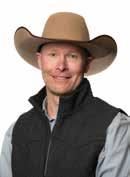
The fast-tracked process of passing Bill C-202 was very frustrating. CCA invested significant resources campaigning against the previous iteration of the bill, Bill C-282. Bill C-202 was exactly the same, and we let Members of Parliament and the Senate know that we view this bill as bad trade policy that pits Canadian agricultural sectors against each other. Unfortunately, it’s not possible for all advocates to achieve the outcome that they want every time. CCA did not publicly share every phone call, letter or meeting about Bill C-202, but I am confident that CCA did everything that we could to try and stop this harmful legislation.
Despite the disappointment, I remain positive. CCA’s commitment to advocacy and good relationships help to secure CCA an invitation to participate in important conversations. It is a significant privilege and responsibility to be asked what support Canadian cattle producers need from the federal government and to be invited to share our opinion and to provide input on policy matters.
At the time I write this message, we are still waiting for details about how Bill C-5 will impact our industry. We have heard public commitments to removing barriers, but fine details are still being worked out.
CCA was very pleased this spring when the Government of Canada announced Public Services and Procurement Canada, on behalf of the Canadian Food Inspection Agency, awarded contracts to Boehringer Ingelheim Animal Health and Biogénesis Bagó SA to supply multiple types of vaccine products and develop Canada’s first foot-and-mouth disease (FMD) vaccine bank. The creation of a dedicated FMD vaccine bank will build on existing protections for the livestock industry and equip producers with another tool to control and eliminate the disease should an outbreak occur. CCA has long advocated for this vital tool. We will continue to work with governments and stakeholders to ensure Canada has a robust emergency preparedness and prevention strategy against FMD.
Finally, I want to share a big CCA staff accomplishment. Executive Vice President Dennis Laycraft recently celebrated his 35th work anniversary with CCA. On the eve of this milestone, he was inducted into the Canadian Agricultural Hall of Fame in recognition of his many years of leadership to the Canadian beef industry. We are proud that Dennis has been recognized for his many accomplishments and look forward to celebrating him at our semi-annual meeting in September in Levis, Quebec. OB

Are You a Competitive Supplier of Weaned Calves?
By Canadian Cow-Calf Cost of Production Network, Canfax and BCRC
The last five years have seen a rapidly shifting landscape with inflated input costs and surging cattle prices. It can be easy to coast, allowing cost structures to rise to the level of cash coming into the operation. But now is the time to set yourself up for the next phase of the cattle cycle. High prices cure high prices; they won’t stick around forever.
How are you investing into your business to be more competitive when prices turn? Are you a competitive supplier of weaned calves? Do you know if you are a high or low-cost producer?
Individual benchmarking allows for incremental improvement from year to year. Comparison to a provincial average tells a producer if they are competitive in the marketplace. Comparison to similar management systems allows producers to identify ways they can improve their competitiveness. The Canadian Cow-calf Cost of Production Network (COP Network) was designed to give producers benchmarks that represent a variety of production and management systems, showcasing incremental steps that can be taken to improve competitiveness. The aggregated results give an indication of what to aim for.
It should be noted that benchmarks are NOT based on who is the most productive. Benchmarks ARE based on who is the most profitable. Benchmarks come from the top third, not the average.
What Costs Are You Covering?
In 2024, with revenue (+16%) growing faster than total costs (+5%), profitability improved across Canada (Figure 1). All benchmark farms covered short-term (cash) costs, and a vast majority (95%) managed to cover medium-term (cash and depreciation) costs (Table 1). Covering depreciation is critical to long-term survival of an operation as it ensures that assets can be replaced. As machinery and repair costs move higher, producers calculating depreciation based on book value can be caught off-guard as replacement costs move higher. About 59 per cent of farms were able to cover long-term (cash, depreciation, and opportunity) costs. Covering opportunity costs represents a return to land, labour and capital, giving producers the signal to expand the herd. In comparison, in 2023, 95 per cent of farms covered short-term costs, 91 per cent covered medium-term costs, and about 50 per cent covered long-term costs.

Overall, average short-term profits were up from $668/cow in 2023 to $919/cow in 2024, medium-term profits up from $465/ cow to $675/cow, and long-term profits were up from -$25/cow to $163/cow. (Table 1). While these figures reflect a positive trend in profitability for 2024, there is significant variability between operations. The top third benchmark farms had short-, medium-, and long-term profits that were 33 per cent, 58 per cent and 306 per cent higher than the average. Some operations have experienced much higher profitability, while others saw less favorable results.

Profit Drivers
The Five Per Cent Rule says that profits are driven by:
1. Marketing - output price (revenue)
2. Productivity - pounds produced/sold
3. Input costs - cash, depreciation and opportunity
When the 64 benchmarks are divided into three equally sized groups based on medium-term profit (see Figure 2) it becomes clear that controlling costs is a major profit driver representing the key difference between the groups. Total costs dropped 21 per cent from the low- to medium-profit group and by another 23 per cent from the medium- to high-profit group supporting a significant 223 per cent and 47 per cent increase in medium-term profit, respectively. Meanwhile, the total revenue had modest gains of seven per cent and one per cent, making a smaller contribution. This highlights the critical role that controlling costs plays in maximizing profits, which is something producers have more control over than output prices.

Figure 1. Canada Average Cost in 2024
Table 1. Summary of 2024 Costs and Profitability ($/cow)
Figure 2. Medium-term profit, total cost and total revenue of low, medium and high profit groups
2025 FALL STOCKER SALES
Schedules are subject to change given the conditions of the industry. Please call the sale contact to confirm details. Sale results will be posted on our website the next
Aylmer Stockyards Inc. Sales Barn: 519-765-2672 Jim Doan: 519-777-9389, Mike VanNoord: 519-808-0904 info@aylmerstockyards.ca • www.aylmerstockyards.ca
Regular sales every Wednesday at 12:00 noon.
Aug
Sept
Brussels Livestock Sales Barn - 519-887-6461, Mark Ferraro - 519-492-0181 Matt Ferraro - 519-313-0583 info@brusselslivestock.ca www.brusselslivestock.ca
Regular
Oct
Nov 7 10:00 a.m.
Kawartha Lakes Community Sale Barn Inc. Sale Barn - 705-439-4444 Fax - 705-439-3145 www.klcauction.ca • info@klcauction.ca
For information on regular stocker sales and bred cow sales, contact Neil Woodrow at 905-404-4526 or Kevin Barker at 705-878-2947.
For the Peterborough/Victoria sales, contact Wayne Telford (Peterborough) at 705-292-9531 or Jim King (Victoria) at 705-374-4004.
Regular sales every Saturday.
Oct 1 10:00 a.m. Woodville KLC Calf &
Angus Influence Sale/Hereford Influence Sale
Cargill Auction Market Inc. Sales Barn - 519-366-2214
Alan Anstett - 519-881-6640 cargillauction@gmail.com
Sept 5 7:00 p.m. Cargill
Sept 26 7:00 p.m. Cargill
Oct 3 7:00 p.m. Cargill
Oct 31 7:00 p.m. Cargill
Nov 7 7:00 p.m. Cargill
Denfield Livestock Sales Ltd.
Calvin Anstett - 519-881-6623
Char. & Exotic YearlingsSteers & Heifers
Char. & Exotic YearlingsSteers & Heifers
Char. & Exotic YearlingsSteers & Heifers
Local calf sale
Local calf & yearling sale
Sales Barn - 519-666-1140 Greg Stanton - 519-636-4756, Jeff Van Soest - 226-448-7224 office@denfieldlivestock.com www.denfieldlivestock.com
Regular sales every Tuesday at 12 p.m. noon (calf sale begins at noon). Check our website for further updates.
Sept 20 11:00 a.m. Denfield
Oct 4 11:00 a.m. Denfield
Oct 18 11:00 a.m. Denfield
Nov 1 11:00 a.m. Denfield
Nov 15 11:00 a.m. Denfield
Nov 22 11:00 a.m. Denfield
Vaccinated calves & yearlings
Vaccinated calves & yearlings
Vaccinated calves & yearlings
Local vaccinated calf sale
Bred cow & cow-calf pair sale
Vaccinated calf & yearling sale
Embrun Livestock Steve Spratt - 613-821-2634 or 613-822-1351 ottawalivestock@bellnet.ca
Regular sales every Monday at 12:30 p.m. Dates for special stocker sales and bred cow sales in the fall will be posted on their website at www.ottawalivestockexchange.ca, or by calling the auction market at 613-821-2634.
Hoard’s Station Sale Barn Sale Barn - 705-653-3660
Sponsored by Quinte Cattlemen’s Association Ab Carroll - 705-344-6654 osi.abcarroll@gmail.com www.hoardsstationsalebarn.com
Quinte Sales Contact - Denton Meiklejohn- 613-395-2008 dentlynnefarms@yahoo.ca
Regular sales every Tuesday. Farm fresh cattle only!
Sept 12 11:00 a.m. Campbellford
Oct 24 11:00 a.m. Campbellford
Nov 21 11:00 a.m. Campbellford
Jan 23/26 11:00 a.m. Campbellford
Mar TBD 11:00 a.m. Campbellford
May TBD 11:00 a.m. Campbellford
Mixed sale, vaccinated preferred, catalogued, farm fresh
100% all vaccinated, catalogued, farm fresh
100% all vaccinated, catalogued, farm fresh
100% vaccinated, catalogued, farm fresh
Vaccinated preferred, catalogued, farm fresh
100% vaccinated, catalogued, farm fresh
Date
MapleHill Auctions Ltd.
Sales Barn: 519-506-1400
Sales Manager - Cory Jacklin: 519-372-5539
Stocker sales starting in September on Monday’s at 7 p.m. Follow us on our MapleHill Auctions Ltd. Facebook page!
Aug 30 5:00 p.m. Hanover
Sept 6 1:00 p.m. Hanover
Sept 13 1:00 p.m. Hanover
Oct 4 1:00 p.m. Hanover
Oct 8 11:00 a.m. Hanover
Oct 17 7:00 p.m. Hanover
Oct 20 7:00 p.m. Hanover
Oct 24 7:00 p.m. Hanover
Oct 27 7:00 p.m. Hanover
Nov 1 1:00 p.m. Hanover
Nov 15 1:00 p.m. Hanover
Nov 22 1:00 p.m. Hanover
Dec 6 1:00 p.m. Hanover
Autumn Angus Classic
Bred cow sale
Ontario Autumn Simmental Classic
Maple Hill Youth Market Lamb Show & Sale
MapleHill Bred Holstein Heifer Sale
“Uppin the Ante” Charolais Female Sale
Limousin Influence Calf Sale
Speckled Park Sale
Local vaccinated calf sale
Top Cut Bred Heifer Sale
Ontario Shorthorn Association Fall Classic
Bred heifer & cow sale
Eastern Showcase Limousin Sale
Ontario Livestock Exchange Office - 519-884-2082
Larry Witzel - 519-741-6333
Calvin Kuepfer: 519-501-0147
David Ropp - 519-749-5072
Allen Colwell - 519-272-3290
dropp@olex.on.ca www.olex.on.ca
Live Sales: Wednesday – vaccinated stocker sale at 1 p.m.
Thursday – regular stocker sale at 11 a.m., followed by bred cows & breeder bulls
Special Vaccinated Calf Sales – First Thursday of each month (in conjunction with our regular sales on Sept 4, Oct 2, Nov 6, Dec 4).
Western Sales: Daily internet presort sales & direct from ranch sales. Please contact David Ropp for details.
Sept 4 11:00 a.m. Waterloo Special vaccinated calf sale
Oct 2 11:00 a.m. Waterloo Special vaccinated calf sale
Nov 3 11:00 a.m. Waterloo Special vaccinated calf sale
Dec 4 11:00 a.m. Waterloo Special vaccinated calf sale
Ontario Stockyards Inc. Office - 705-458-4000
Ab Carroll - 705-344-6654 Brian Pascoe - 705-878-6918
osi.abcarroll@gmail.com www.ontariostockyards.on.ca
Follow the Facebook page at Ontario Stockyards for weekly updates and market information! Regular weekly stocker and feeder sales every Thursday at 11 a.m. All regular sales will start with vaccinated cattle first. Bred cow sales to be announced at a later date. Visit www.ontariostockyards.on.ca for updates.
Sept 18 11:00 a.m. Cookstown Special All Breeds Pre-sort Sale
Sept 25 11:00 a.m. Cookstown Special Fall Yearling Sale
Oct 2 11:00 a.m. Cookstown CDN Angus Program/CDN Hereford Association Sale In conjunction with regular Thursday Sale
Oct 9 11:00 a.m. Cookstown Special Fall Yearling Sale
Oct 16 11:00 a.m. Cookstown Special All Vaccinated Calf Sale
Oct 23 11:00 a.m. Cookstown Special Fall Yearling Sale
Oct 30 11:00 a.m. Cookstown
Special All Breeds Pre-sort Sale
Nov 6 11:00 a.m. Cookstown Special All Vaccinated Calf Sale
Nov 13 11:00 a.m. Cookstown Special Angus/Hereford Sale
Nov 20 11:00 a.m. Cookstown Special All Vaccinated Calf Sale
Nov 27 11:00 a.m. Cookstown Special All Breeds Pre-sort Sale
Dec 4 11:00 a.m. Cookstown Special All Vaccinated Calf Sale
Dec 11 11:00 a.m. Cookstown Special Fall Yearling Sale
Dec 18 11:00 a.m. Cookstown
Special All Breeds Pre-sort Sale
Ottawa Livestock Exchange Steve Spratt - 613-821-2634 or 613-822-1351 www.ottawalivestockexchange.ca ottawalivestock@bellnet.ca
Regular sales every Thursday at 12:30 p.m. Dates for special stocker sales and bred cow sales in the fall will be posted at www.ottawalivestockexchange.ca, or by calling the auction market at 613-821-2634.
Rainy River Cattlemen’s Sales - Stratton Sales Barn
James Gibson: 807-487-2731 or 807-271-2005
Sale Barn week of sale - 807-483-5354 katjames24.kg@gmail.com www.rainyrivercattlemensassociation.com
Sales will be available via DLMS Network. Please sign up and request to bid early and prior to the sale starting. If you are planning to purchase over the network, you will need to call the sales barn office to set up an account. Sept 6 8:30 a.m. Stratton
Cows and bulls start the sale at 8 a.m. Protocol cattle (vaccinated cattle) will sell at 1 p.m., majority are age verified
Sept 27 8:30 a.m. Stratton
Oct 18 8:30 a.m.
Nov
- 613-646-7335 or 613-602-7253 Matt Dick: 613-633-1598
Stocker sales will be held every Tuesday with the regular sale. Bred cow sales will be announced prior to sale date.. Temiskaming Livestock Sales Bill Stewart -705-544-3508 Sale Barn - 705-647-5415
Regular sales every Monday.
Oct 17 12:00 p.m. New Liskeard 600 Special calf and yearling sale
Oct 31 12:00 p.m. New Liskeard Bred cow sale
Vankleek Hill Livestock Exchange Sale Barn - 613-678-3008 vkhlivestock@gmail.com
Stocker sales will be included in the last Wednesday sale of each month beginning in August.
Aug 27 1:00 p.m. Vankleek Hill Stocker sale
Sept 24 1:00 p.m. Vankleek Hill
Northern Cattle Sales Network
Visit Northern Cattle Sales Network on Facebook. View cattle on offer at upcoming sales, post pictures or descriptions of your own cattle that will be on sale at upcoming northern auction sales, free!
Hoards Station Sale Barn
Sponsored by Quinte Cattlemen’s Association
Quinte Sales Contact - Denton Meiklejohn: 613-395-2008 or dentlynnefarms@yahoo.ca
Farm fresh cattle only!
Sept 12 11:00 a.m.
Oct 24 11:00
Nov 21 11:00 a.m.
Jan 23/26 11:00 a.m.
Mar TBD 11:00 a.m.
May TBD 11:00 a.m.
sale, vaccinated preferred, catalogued, farm fresh
vaccinated, catalogued, farm fresh
vaccinated, catalogued, farm fresh
Vaccinations preferred, catalogued, farm fresh
100% vaccinated, catalogued, farm fresh
Kawartha Lakes Community Sale Barn Inc. Sales Barn - 705-439-4444 Peterborough Cattlemen’s sales contact - Wayne Telford - 705-292-9531 Victoria Beef Producers sales contact - Jim King -
Peterborough Cattlemen/ Victoria Beef Producers Calves & yearling sale. Cattle from surrounding counties invited.
Jan 28/26 10:00 a.m. Woodville 500 Peterborough Cattlemen/ Victoria Beef ProducersCalves & yearling sale. Cattle from surrounding counties invited.
May 6/26 10:00
Peterborough Cattlemen/ Victoria Beef Producers Grass cattle and yearlings. Cattle from surrounding counties invited.
Thessalon Sale Dennis Kirby cell - 705-842-2249
Sponsored by Algoma Co-operative Livestock Sales Sept 16
Cows and bulls start the sale at 8 a.m. Protocol cattle (vaccinated cattle) will sell at 1 p.m., majority are age verified
Cows and bulls start the sale at 8 a.m. Protocol cattle (vaccinated cattle) will sell at 1 p.m., majority are age verified
Wiarton Sale Terry Moser - 519-375-7957
Sponsored by Grey-Bruce Livestock Co-operative terry-moser@hotmail.com
Please note that sale dates are tentative. Please contact Terry Moser to confirm.
Controlling Costs
Overall, total production costs per cow have an upward sloping supply curve (Figure 3), with both low-cost and high-cost production systems represented.

In 2024, the average total cost (Table 1) rose to $1,850 per cow, up five per cent from 2023. The increase was more pronounced in the East, where costs increased from 2023 by seven per cent, compared to a 4 per cent increase in the West since 2023. The larger cost hike in the East is primarily due to inflationary pressures offsetting the effects of the 2023 drought in the West, as well as increased demand from Western producers purchasing winter feed from the East in 2023.
Breaking down the total costs, 59 per cent ($1,094) were cash costs, 13 per cent ($244) depreciation, and 28 per cent ($512) were opportunity costs. These are consistent with the previous year, which had 61 per cent cash costs, 11 per cent depreciation, and 28 per cent opportunity costs.
Continuous Improvement
The difference, when comparing the costs for the top third farms to the bottom two-thirds (Figure 4), has widened ten percentage points from 2021 to 2023 from 20-30 per cent for cash and 38-48 per cent for depreciation costs. This represents the top third making continuous improvements in their operations. This widening gap shows how those who are most competitive cement their position during profitable times.
WHAT IS THE COP NETWORK?
The Canadian Cow-calf Cost of Production Network (COP Network) uses standardized data collection which allows for comparison both within and between provinces, and internationally. Since launching in 2021, the COP Network has collected data from over 235 producers contributing to 64 cow-calf benchmark farms that represent various production systems. Each benchmark is based on data from three to seven producers. Data collection occurs every five years with annual indexing of input and output prices, as well as crop and forage yields, in subsequent years. Individual benchmark farm summaries, can be found at: https://canfax.ca/resources/cost-of-production/cop-results.html
Total costs for top-performing farms are 24 per cent to 32 per cent lower than those of the bottom tier, driven by consistent double-digit reductions in cash costs, depreciation, and opportunity costs across all years. It is worth noting that the top third group does not focus on just cash costs but is controlling every aspect of their cost structure. In contrast, weaned calf prices show only modest variation between top and bottom farms, with differences ranging from two per cent to six per cent, underscoring the limited influence producers have over market prices. As cattle prices have increased in recent years, the total revenue gap has narrowed—from 16 per cent in 2021 to just four per cent in 2024 - suggesting that when prices are high, all cow-calf producers benefit. But when the price cycle turns, it should not be forgotten that these top-performing operations not only control costs but also received more revenue. It is never too late, nor too early to start working on developing reputation cattle.

Preparing for the Next Phase of the Cattle Cycle
At the top of the price cycle, producers have an opportunity to strategically set themselves up for the future. Reinvesting profits into operational improvements, genetic advancement, or resource efficiency can serve as a proactive hedge against the cyclical nature of the cattle market.
While the shrinking cattle supply has shifted market leverage toward cow-calf producers, enhancing profit potential, it has simultaneously increased exposure to market volatility, with large price ranges. Cost control combined with building reputation cattle can buffer operations against price volatility and enhance resilience in subsequent phases of the cattle cycle. Thoughtful planning during this phase is essential to ensure sustainability and competitiveness as the industry transitions into the next cycle.
Figure 3. Total costs ($/cow) on benchmark farms in 2024
Figure 4. Percent Difference Between Top Third and Bottom Two-Third, based on Medium-Term Profits
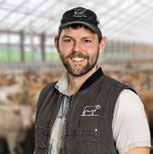
AsFOCUS ON HERD HEALTH
By Jacques van Zyl, DVM, Metzger Veterinary Services
Rumen Health 101: Preventing Acidosis in Beef Cattle
beef producers, you put a lot of effort into getting cattle to gain well and stay healthy. But sometimes, the biggest problems are the ones we can’t see. One of those is rumen acidosis—a digestive issue that can quietly cost us money and set cattle up for other health problems.
This article explains what acidosis is, why it matters, how it affects more than just digestion, and what tools can help prevent it.
What is Rumen Acidosis?
The rumen is the first stomach chamber in a cow. It’s full of bugs (microbes) that break down feed and turn it into energy. These bugs need the rumen to stay at a steady pH - basically, not too acidic and not too basic (alkaline).
Acidosis happens when the rumen becomes too acidic (hence the term acidosis). This usually occurs when cattle eat too much grain or feed that ferments quickly (like pellets or finely ground corn), especially if they aren’t used to it yet.
There are two types:
• Acute acidosis – a quick, sharp drop in rumen pH. This can make cattle very sick, fast.
• Subacute acidosis – a lower pH that happens off and on over time. You might not notice it right away, but it can cause poor gains and health issues.
Why Should You Care?
Cattle with acidosis don’t perform well. They eat less, gain less, and are more likely to get sick.
Some signs you might see:
• Loose or foamy manure
• Cattle going off feed, then eating again later
• Undigested grain in manure
• Slower weight gain than expected
• Lameness or hoof problems (linked to acidosis causing sore feet)
Even if cattle look okay, acidosis in the herd can quietly take away profits without you realizing it.
What Causes It?
Acidosis is usually caused by too much fast-fermenting feed and not enough fibre to balance things out.
Here are some common culprits:
• Switching cattle to grain too quickly
• Not enough hay or roughage in the diet
• Cattle sorting through the feed and eating the grain first
• Overcrowded bunks where aggressive animals overeat
• Skipping a feeding and then loading the bunk the next day
It’s Not Just a Gut Problem
When the rumen goes out of balance, the rest of the animal suffers too.
Here’s how:
• Weaker immune system: Acid buildup can cause inflammation in the animal’s body, making it harder to fight off disease.
• More respiratory illness (pneumonia): Cattle with poor rumen health are more likely to come down with pneumonia or get sick during stress periods.
• Liver abscesses: Acidosis can cause damage in the rumen wall, letting bacteria travel to the liver. These liver abscesses don’t always show on the outside, but they lower performance and cause carcass trim at slaughter.
• Sore feet and lameness: Toxins released during acidosis can cause hoof problems, leading to lameness.
• Sudden death or bloating: In severe cases, the rumen stops working properly and cattle may die quickly.
How to Prevent Acidosis
The good news? Acidosis is preventable with proper management and a few helpful tools.
1. Don’t Rush Grain
Always step cattle up slowly when moving them onto higher grain or pelleted diets. Give their rumen microbes time to adjust—this usually takes two to three weeks.
2. Feed Enough Fibre
Even on a finishing ration, cattle need roughage like hay or straw to keep chewing their cud and producing saliva. Saliva helps keep the rumen from getting too acidic.
3. Watch Feed Bunks
• Feed at the same time every day.
• Don’t let the bunk run empty, then overfill it.
• Give enough bunk space so everyone can eat calmly.
• Avoid sorting—if cattle are picking through the feed, they’re likely eating more grain than they should.
4. Pay Attention to Manure and Behaviour
• Is the manure runny or bubbly?
• Are cattle chewing their cud after meals?
• Are they eating calmly or rushing the bunk?
• Do you hear cattle grinding their teeth when walking the pen?
Continued
These small details tell you a lot about what’s going on inside the rumen.
Products That Help: Ionophores and/or Lactipro
Even with good management, some cattle are more prone to acidosis—especially newly arrived calves or those moved onto grain quickly. That’s where feed additives and probiotics can help.
Ionophores (Monensin, Lasalocid)
These are common feed additives that:
• Reduce acid-producing bacteria in the rumen
• Help stabilize rumen pH
• Improve feed efficiency
• Lower the risk of bloat and liver abscesses
They’re usually added to the feed or mineral mix and are a great long-term tool for reducing digestive issues.
Lactipro (Megasphaera elsdenii)
Lactipro is a probiotic—it adds good bacteria to the rumen that eat up excess lactic acid, the main cause of acidosis.
Why is that important?
• When cattle start eating more grain, lactic acid builds up faster than the rumen can handle.
• Lactipro fills that gap. It adds bacteria that consume the acid, keeping the rumen in balance.
• It’s given as a one-time oral drench, often at arrival or when changing diets.
When Should You Use Lactipro?
• When receiving high-risk or stressed calves
• When starting cattle on a high-grain ration
• After a break in feeding (like a missed feeding or time away from the bunk such as terminal implanting)
• When stepping up cattle quickly
Lactipro works well alongside ionophores and is especially helpful for high-risk pens where cattle might be more sensitive to feed changes.
Final Thoughts
Rumen acidosis is a hidden problem in many beef herds. It’s not just about digestion—it weakens cattle and opens the door to other illnesses. If you’re seeing poor gains, off-feed cattle, loose manure, or higher-than-normal treatment rates, acidosis could be playing a role.
But with the right plan—good feeding practices, close observation, and the right products—you can keep cattle healthier, gaining better, and performing at their best.
Talk to your vet or nutritionist if you think acidosis might be affecting your herd. They can help review your feeding program and make suggestions for improvement. Small changes can make a big difference in performance and animal health. OB









OntarioMARKET INFORMATION UPDATE
By Jamie Kerr, Market Analyst for Canfax and BFO markets@ontariobeef.com • www.ontariobeef.com
fed steer prices continued to move higher in the second quarter of 2025, climbing $25/cwt from the first quarter to average $299/cwt live. Prices were up $56/cwt from last year and $107/cwt above the five-year average. Following seasonal trends, fed steers put in their first half of the year highs in June. Ontario fed steers were at a $4/cwt premium to the Alberta market during the second quarter, including a $12/cwt premium in June. However, the Ontario fed market was at an $11/cwt discount to U.S. (all area average) fed steers.
Both the five-year index and the live cattle futures (converted to Canadian dollars with historical basis) shows a softer third quarter with a small rebound higher to end the year. As of mid-July, the U.S. once again closed their border with Mexico to live cattle imports, impacting Southern U.S. feedlot and packing plant utilization rates.
Ontario fed processing volumes averaged 8,350 head/week in the second quarter of 2025, 5 per cent lower than the five-year average. The Cargill Guelph plant shutdown for a six-week period, including the entire month of June 2024 impacted year-over-year comparisons. Non-fed processing averaged 1,450 head/week in the second quarter down 9 per cent from the five-year average. Steer carcass weights averaged 963 pounds, 16 pounds heavier than the five-year average. Ontario fed exports to the U.S. during April and May totaled 12,400 head, up 43 per cent from the five-year average. The Ontario-toNebraska cash basis improved $8/cwt compared to the first quarter, to -$16/cwt. However, it was $13/cwt weaker than the five-year average and was the weakest on record for the second quarter going back to 2020, when pandemic disruptions occurred.
Cull cows put in new all-time highs for each of the past three months, supported by reduced U.S. cow processing and strong demand for lean trim. Ontario D2 cows averaged $205/cwt, up $39/ cwt from last year and up $84/cwt from the five-year average. Ontario D3 cows averaged $164/cwt, up $30/cwt from last year and up $68/ cwt from the five-year average. Cull cows sold through commercial

auction marts in the second quarter totaled 21,500 head, down 18 per cent from last year and down 23 per cent from the five-year average. There was a notable 41 per cent reduction in volumes in May compared to a year ago. Ontario D2 cows were at a $28/cwt discount to the Alberta market in the second quarter and a $15/cwt discount to U.S. utility cows.
Ontario non-fed exports totaled 7,400 head in April and May, down 7 per cent from the five-year average. The larger discount against the western Canadian market may have encouraged some eastern Canadian beef cows to be shipped west for slaughter.
The feeder cattle market was hot in the second quarter of 2025 with a significant price adjustment occurring in April as most prices moved from being discounted to the west, to being at a premium. Most classes of grass-type steers peaked in May establishing new all-time highs, with a slight seasonal decline moving into June. Lightweight 4-500-pound steers and steers over 900 pounds continued to move higher between May and June. Most classes of heifers moved higher between April and June.
Year-over-year, steer calves from 400-699 pounds were $117-143/ cwt stronger than a year ago in the second quarter of 2025. Heifer calves from 300-599 pounds outperformed their steer counterparts, climbing $135-166/cwt since the second quarter of 2024.
Ontario 550-pound steer calves were at a $3/cwt premium to Alberta calves and a $13/cwt premium to the U.S. in the second quarter. These light feeder steers were the most expensive in North America in May and June, after being at a discount during the first four months of 2025.
Yearling steers from 700-899 pounds moved $101-106/cwt higher compared to a year ago with yearling heifers from 600-799 pounds, up $98-129/cwt. Ontario 850-pound feeder steers were also the premium market in the second quarter, averaging $26/cwt higher than Alberta and $36/cwt higher than U.S. 850-pound steers in the
Continued on page 40.

second quarter. Heavy yearling steers over 900 pounds increased $81-86/cwt with heifers over 800 pounds moving $78-93/cwt higher.
Using the feeder cattle futures, Canadian dollar and historical basis, Ontario 850-pound feeder steers are projected to peak in September and grind lower through the fourth quarter.
The yearling steer monthly trends report estimates yearling steers (on the cash market with no risk management) placed in October, November, and December 2024 and marketed in April, May, June 2025 at $263/cwt. These steers averaged $30/cwt in the black. The breakeven for yearling steers placed in April, May, and June 2025 for the fourth quarter are estimated at $300/cwt.
Second quarter Canadian auction volumes were down 5 per cent from last year and were down a moderate 3 per cent from the fiveyear average. In Ontario, second quarter auction volumes totaled 108,000 head, down 8 per cent from last year and down 3 per cent from the five-year average. Larger auction volumes in April (+3,500 head) and June (+3,000 head) were not enough to offset smaller May volumes (-16,000 head).
Special stocker sales will soon be underway across the province. To view the list of scheduled dates, turn to page 34.
We have many options to help producers track current pricing, all free of charge. You can access current market information at: www.ontariobeef.com go to Market Info and select from the various
options. Auction market results are posted the next day under Auction Markets - Individual Auction Market Reports. A noon report is posted daily with updates from sales in progress that day. Daily and Weekly reports are also posted by 4:30 pm with information on the sales of the day, other markets and the Chicago Mercantile Exchange closing figures. The Daily is available on our website, or via email or fax. The Weekly is available on our website, via email, fax and by regular mail every Friday afternoon. If you are interested in receiving any of the reports free of charge, please call the office 519.824.0334 to make arrangements. OB

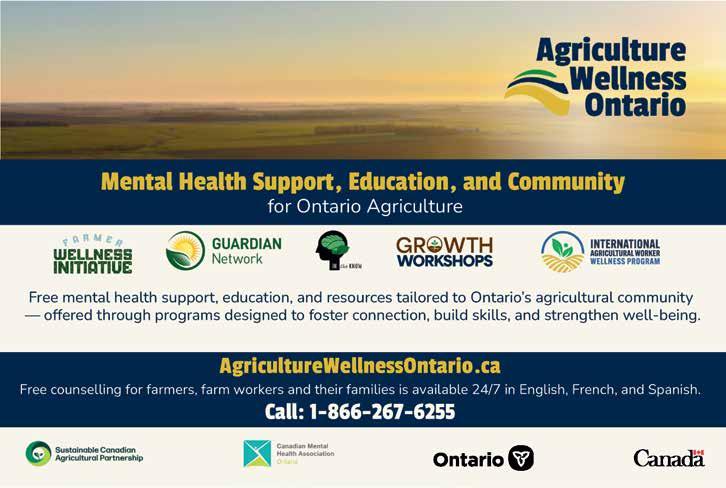


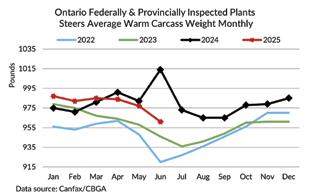
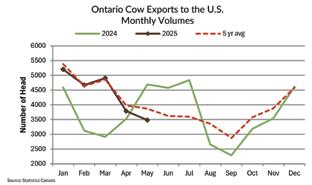
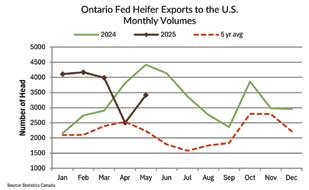


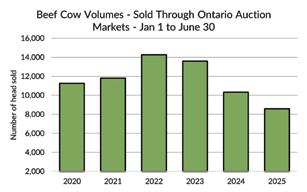

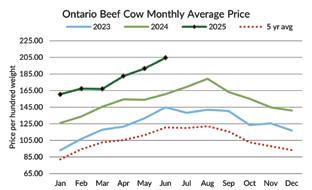






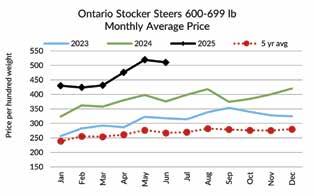
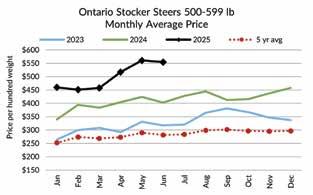






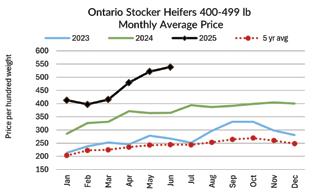
LIVE CATTLE EXPORTS-ONTARIO
BEEF EXPORTS – CANADA (AAFC)
LIVE CATTLE – CANADA (AAFC)
BEEF PRODUCTION – CANADA (AAFC)
BEEF IMPORTS – CANADA (AAFC)
CALENDAR
Ontario Beef Industry Events
August 22-23 – Cow-Calf Management Tour, Lennox & Addington and Frontenac Counties. Visit www.ontariobeef.com for details
September 6 – Charolais Show, Renfrew Fair, Renfrew
September 9-11 – Canada’s Outdoor Farm Show, Woodstock, Ontario
September 13 – Ontario Autumn Simmental Sale, Hanover
September 16-20 – International Plowing Match and Rural Expo, Niagara Region
September 19 – Charolais Show, Lindsay Exhibition, Lindsay
September 19 – River Valley Herefords Genetic Designs Sale, Newburgh
September 20 – Elm-Lodge Polled Herefords and Friends Source for Success XXIII Sale, Indian River

Daryl and Connie Clarke and Family 342 Chatham Street South, Blenheim, Ontario N0P 1A0
Herdsman and Marketing Manager Hugh M. Ross: 519-365-4026 hugh.clarkeffi@gmail.com
September 21 – Medonte Highlands Polled Herefords and Friends Autumn Alliance Sale, Orillia
October 4 – National Blonde d’Aquitaine Show, Markham Fair, Markham
October 4 – Ontario Simmental Solution Sale, Staffa
October 4 – Futures One Simmental Sale, Staffa
October 5 – Indian River Cattle Co Quality Control IX Female Sale, Indian Rive
October 6 – Koyle/Stewart/Miller 3rd Annual Online Sale, Iona Station
October 17 – Uppin’ The Ante Charolais Female Sale, Hanover
October 18 – Fall Feature Charolais Sale, Hoard’s Station
October 18 – 78th Edition Blue Water Angus Sale, Cargill
October 18 – Stars o the Valley Simmental Sale, Melcalfe
October 19 – River Point Cattle Co and Guests Fall Gala Sale, Glencoe
October 20 – Limousin Influence Sale, Hanover
October 25 – Cream of the Crop Blonde d’Aquitaine Sale, Hoard’s Station
October 26 – Leahy Livestock Select Bull and Female Sale, Indian River
October 30 – Limousin Influence Sale, Cargill
November 1 – Dudgeon Cattle Co and Guests Top Cut Bred Heifer Sale, Hanover
December 30 – Premier and Guests Falls View Production Sale, Toronto


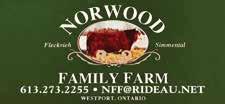

No Longer Licenced
Country Dealer
1267388 Ontario Incorporated o/a Gingerich Veal Transport, Harriston, ON
Auction Market
David Carson Farms & Auction Services Ltd., Listowel, ON
Now Licensed
Country Dealer
Darryl Evans, Almonte, ON Holstock Farm Ltd., Harriston, ON
Abattoir: Georgian Bay Meat Packers Inc. o/a Stayner Meat Packers, Coldwater, ON
The Ontario Beef Cattle Financial Protection Program is administered by Agricorp. The listing of licensed dealers is updated regularly and the complete listing can be found on the Agricorp website. OB
BEEF FARMERS OF ONTARIO PRIVACY STATEMENT
The Beef Farmers of Ontario (BFO) is committed to protecting the privacy and security of producers’ personal information in compliance with the Personal Information Protection and Electronic Documents Act (PIPEDA).
Subscribers to Ontario Beef magazine, the official publication of the Beef Farmers of Ontario, do so on a voluntary basis. By subscribing, subscribers are consenting to have their contact information used for the purposes of receiving the magazine and developing an BFO mailing list.
This mailing list will be used for the distribution of the BFO magazine.
The BFO will not sell, trade or otherwise share its Ontario Beef mailing list under any circumstances. A service may be provided whereby items are submitted to the BFO and mailed internally with the magazine but all materials must be approved by and acceptable to the BFO. In rare instances where external, non-commercial organizations, like the provincial or federal government, wish to use the Ontario Beef mailing list to distribute information, the government must provide their mailing materials in a finished format to BFO and/or its mailing house. BFO will then coordinate the mailing, at the requesting organization’s cost, thus maintaining confidentiality of the list. In cases where the BFO may commission a mailing, the company providing the service is required to sign a mandatory confidentiality agreement.
Subscribers to the Ontario Beef mailing list who wish to have their names removed, should call 519-824-0334 or email info@ontariobeef.com. Please allow 15 business days to allow us to update our records accordingly.
BFO’s complete privacy statement, covering areas of information including the electronic update system, Website, membership list and market information can be viewed on its Website at http://www.ontariobeef.com/privacy.asp
SILVERTIP





Cell: 519-372-7459 Sheila’s Cell: 519-379-4877 smartlimousin@gmail.com www.smartlimousin.com








WELLNESS ON THE FARM
By Lesley Kelly, Farmer and Co-founder of The Do More Agriculture Foundation
Just Because It’s Normal, Doesn’t Mean It’s Healthy
Farming is a way of life and a business. It’s long hours, unpredictable conditions, and a deep connection to the land. It’s also a career filled with pride, purpose, and resilience. Over time, we’ve normalized a lot of things in agriculture that, if we’re being honest, aren’t healthy. We’ve come to accept that exhaustion is just part of the job, that stress is something we carry without question, and that emotions should be shoved down and dealt with later, if at all. We avoid hard conversations because “that’s just how they are.” We push through burnout because the work won’t wait. We’ve told ourselves this is normal.
Just because something is normal doesn’t mean it’s natural, and it sure doesn’t mean it’s good for us.
The Weight We Carry in Agriculture
Farming comes with an incredible amount of responsibility. We don’t just clock in and out; we live this job every single day. There’s no guaranteed paycheck, no “slow season” that truly lets us rest, and no way to control the markets or the weather. The stress builds up, and for many, it sits in our bodies like an invisible weight (tight shoulders, clenched jaws, and restless nights).
And yet, instead of acknowledging how heavy that burden is, we convince ourselves to push through it. We say, “That’s just farming.” Yet at what cost?
We wouldn’t expect our equipment to run without maintenance, yet we treat our own bodies and minds as if they can function indefinitely without care. We know stress and exhaustion affect our decision-making, our health, and our relationships, yet we keep going until we hit a breaking point.
Here’s how:
Rest Isn’t a Reward. It’s a Necessity.
Rest isn’t something you “earn” after the work is done. The work will never truly be done. Taking breaks, sleeping well, and allowing yourself time to recover makes you more productive in the long run.
Feel Your Emotions Instead of Burying Them.
We’ve been taught to “suck it up” and move on, yet emotions don’t just disappear. They show up in other ways; short tempers, resentment, and even physical health issues. Talking about stress, frustration, or grief doesn’t make you weak. It helps you move through it.

It’s Time to Shift the Narrative
Mental health is just as important as physical health, and taking care of it doesn’t make you weak. It makes you a better and healthier farmer, parent, spouse, and friend. If we want to be in this industry for the long haul, we need to start rethinking the way we operate.
Have the Hard Conversations. Avoiding tough discussions whether it’s about succession planning, financial struggles, or family tension only makes things harder down the road. Facing them head-on may be uncomfortable, yet it prevents years of unspoken stress.
Let Go of the Lone Wolf Mentality. Farming can be isolating and you don’t have to do it alone. Lean on your family, neighbours, peer support groups, or professionals when you need help. There’s no shame in seeking support. It’s one of the strongest things you can do.
Listen to Your Body.
That stress you’re carrying in your back? Those headaches that keep coming back? That exhaustion that never fully goes away? It’s not just “part of farming.” It’s your body telling you something needs to change. Pay attention to it.
A Healthier Future for Farmers
Farming will always come with challenges, yet how we handle them can change. We don’t have to accept stress, exhaustion, and emotional suppression as part of the job. It’s time to break the cycle and redefine what’s “normal” in agriculture.
Because at the end of the day, the farm needs you. And in order to keep showing up for it, you need to take care of yourself too. OB
